































• Anyone resistant to pharmaceutical treatment


































• Anyone resistant to pharmaceutical treatment

• Deconditioned patients needing strength and balance training
“I
can pick up a bag of potting soil better now.”
• Anyone with balance and fall risk
steoStrong of Pinehurst is a wellness program that focuses on skeletal strengthening. Under the direction of one of OsteoStrong’s skilled technicians, members do a series of exercises that provide high impact results to the members’ bones, posture, and balance. Using musculoskeletal treatment devices, they work through a series of exercises that hack their bodies into increasing their own bone density.
“The earlier you start caring about your bone strength and balance, the stronger you will be throughout your lifetime!”
“I
have my balance back”
Dr. Kyle WHO CAN BENEFIT?
The difficulty with maintaining bone health as people age is that when balance or strength weakens, people tend to want to protect themselves by not doing the high impact activities that can make their bodies naturally strengthen bone. There are pharmaceutical options that are the medical community’s first line of defense for treating bone loss, but sometimes those medicines have side effects that preclude individuals from continuing to take them.
• Individuals experiencing poor posture
“The earlier you start caring about your bone strength and balance, the stronger you will be throughout your lifetime!”
• Anyone with Osteopenia or Osteoporosis
• Anyone resistant to pharmaceutical treatment
Many clients come post-cancer treatment, trying to rebuild their strength and bone density after chemotherapy.



“I
regained ½ inch in height!”
OsteoStrong’s treatments are also highly effective as a preventative measure, for keeping bones stronger, helping to prevent falls or skeletal damage from falls or injuries in the first place. After a treatment session, members have the added benefit of red light therapy treatment with medical-grade LEDs. The wavelengths of the red light treatments are said to encourage healing and regeneration, stimulate the healing process, improve osteoarthritis and even boost skin collagen production. Pair that with hydro massage therapy, which is a chair outfitted with jets that soothes muscles and stimulates the circulatory and lymphatic system.
• Deconditioned patients needing strength and balance training
• Anyone with balance and fall risk
• Individuals experiencing poor posture
• Anyone in need of post-physical therapy strengthening
“I don’t limp anymore”
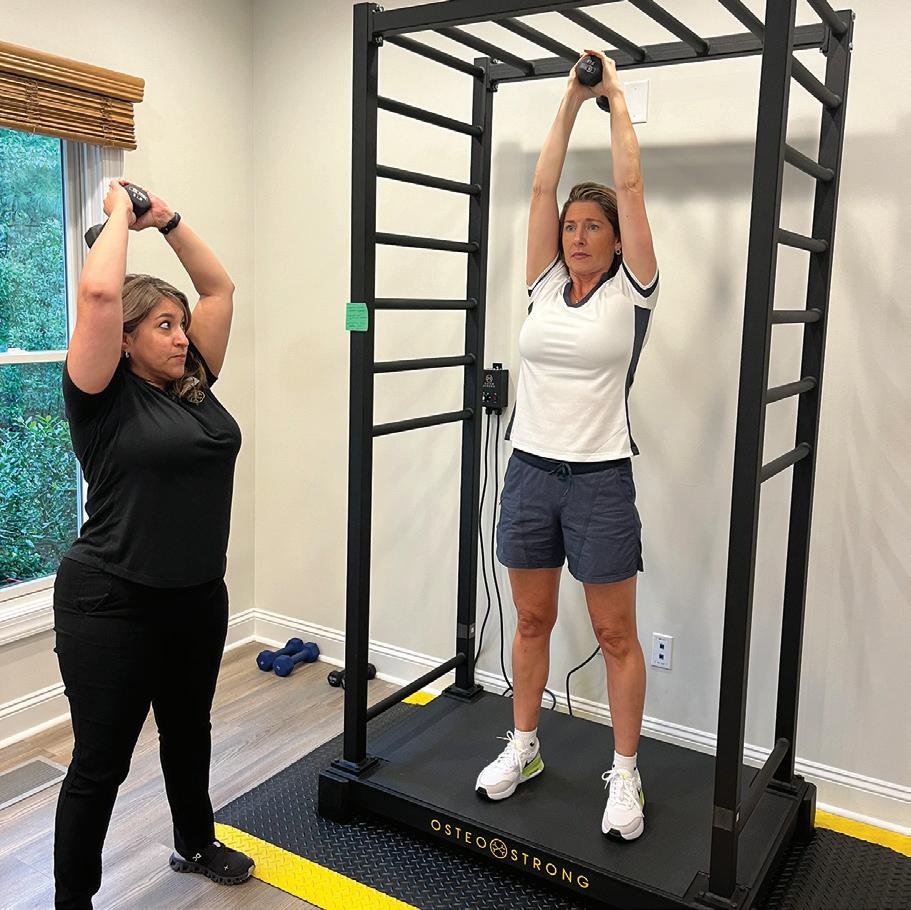
• Anyone in need of post-physical therapy strengthening

• Anyone with Osteopenia or Osteoporosis
• Anyone resistant to pharmaceutical treatment

• Deconditioned patients needing strength and balance training
• Anyone with balance and fall risk
• Individuals experiencing poor posture
OsteoStrong’s treatments can be used in conjunction with those medical treatments or in place of them, in a safe and controlled environment that can help even some of the most high-risk patients.
“My doctor was amazed at my progress”
• Anyone in need of post-physical therapy strengthening

OsteoStrong is used by men and women of various walks of life, athletes, pre- and post-menopausal women, individuals experiencing chronic pain or poor posture, deconditioned patients needing strength and balance training, individuals experiencing chronic pain or poor posture, and anyone in need of post-physical therapy strengthening. There is no membership pressure, or lengthy commitments. Stop by and book an appointment today!
“I can now walk and step over objects without pain in my hip. It is such a relief.”







Penick Village invites you to join our community, where we’re not just redefining retirement living, we’re elevating it to new heights.
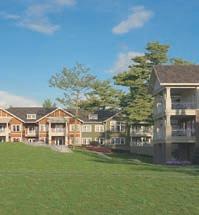


Embrace an Active Lifestyle: Indulge in activities at our state-of-the-art Wellness Pavilion, from Pickleball to personal training and more. Each designed to keep you healthy and engaged.
Crafted Residences: Experience the perfect blend of luxury and comfort in our Independent Living residences, thoughtfully designed to provide a stylish space where you can truly feel at home.
Exceptional Healthcare: The Terrace, our health services building, is being enhanced and renovated, ensuring personalized care, whether short-term therapy or long-term care.
Welcoming Environment: Feel right at home from the moment you arrive. Our updated Welcome House and friendly security team are here to greet you and your guests.
Learn more about Penick Village, where you have the freedom to focus on your wellness and relationships while living life to its fullest . Contact us today. Call (910) 692-0300 , email info@penickvillage1964.org , or scan the QR code to learn more.




Nestled amidst the idyllic landscape of Forest Creek Golf Club, Westwood emerges as a prestigious and visionary residential development. These custom homes are thoughtfully planned by Mark Wesley Parson Design to create a harmonious balance between architectural innovation and the tranquility of nature. With a strong emphasis on outdoor living spaces and manicured landscapes, the design of each home in Westwood is complementary to the adjacent residences. These newly developed 25 acres beckon those with a discerning taste to secure a coveted address in this vibrant community. Prices starting at $1.4 million.

Colony Partners’ Property Management team, led by Jordin Mellott, offers exclusive representation for Forest Creek Golf Club rentals, and welcomes all Pinehurst homeowners looking to maximize the potential of their properties. Whether your goal is long-term stability or short-term gains, we provide full-service support. Enjoy complete peace of mind and let us handle all the details.
Contact Jordin today to maximize your property’s potential and achieve your investment goals! jmellott@colonypartners.com or 910.725.2414

Congratulations to Kathy Peele of Colony Partners for her professional representation of the new owners in the recent sale of this stunning Village Home in Forest Creek Golf Club. This transaction set a new benchmark in Moore County for a residential home, selling at $3.6 million.


Kathy Peele Broker
Colony Partners Realty Group
Jordin Mellott Property Manager Broker
Colony Partners Realty Group




Sleep plays a vital role in the body’s cycle of rejuvenating, healing, and growing. The DUX® Bed’s unique, customizable component system provides unrivaled ergonomic support to help you experience significantly higher quality sleep. The DUX Dynamic combines the best that a traditional DUX bed has to offer, with the added advantage of adjustability. Not only can you customize each side of the bed for optimal support and comfort with our patented Pascal system of interchangeable cassettes, but now with a simple press of a button on a handheld controller you can choose a sleeping position separate from your partner. Resolve to invest in your health. Visit a DUXIANA® store near you and discover why The DUX Bed is more than just a bed, it’s the first step to a better, healthier way of living. Coupon Code: DOWN



















PINEHURST • $307,000 250 SUGAR GUM LANE, UNIT 135
Great 1 BR / 1 BA 1st floor, waterfront condo on Lake Pinehurst! Fully furnished with beautiful water views along the back. Perfect for an investment property or golf get away.


SEVEN LAKES NORTH •$345,000
103 PINENEEDLE DRIVE
Wonderful 3 BR / 2 BA ranch style home located in popular 7LN. Main living area is spacious with large kitchen and large back deck overlooking the back yard. This home has lots of appeal!


ABERDEEN • $479,900
519 N. SYCAMORE STREET
Beautiful newly constructed 4 BR / 2.5 BA move-in ready two-story home. Layout is bright and open with nice finishes throughout. All 4 bedrooms and 2 baths on upper level.






CAMERON • $269,000 210 SCRANTON COURT
Charming 3 BR / 2.5 BA home with large, fenced backyard, paver patio and fire pit. Main level is spacious with hardwood flooring and corner fireplace while the upper-level houses all 3 bedrooms and 2 full baths.


PINEHURST • $499,900
450 SPRING LAKE DRIVE
New construction underway in Village Acres! Two-story 4 BR / 2.5 BA home with open living area on main floor and all 4 bedrooms and 2 baths on upper level.


PINEHURST • $425,000 355 PINE VISTA DRIVE
Lovely 3 BR / 2 BA brick home in popular Lake Pinehurst area. Open and spacious floorplan all on one level with a gorgeous den/study with exposed ceiling beams and fireplace with brick hearth and a wall of bookcases!


SEVEN LAKES NORTH • $459,000 159 EDGEWATER DRIVE
Great 3 BR / 2 BA split plan home on large lot in great community. Home has been completely updated throughout! New paint, new flooring in bedrooms, new windows and encapsulated crawlspace just to name a few!


PINEHURST • $445,000
10 TANDEM DRIVE
Amazing 4 BR / 2.5 BA two-story colonial home situated on double lot in quiet cul-de-sac location. The floorplan is well-appointed and the home has been lovingly cared for!


ABERDEEN • $449,900 515 N. SYCAMORE STREET
Beautiful newly constructed 4 BR / 2.5 BA move-in ready two-story home. Layout is bright and open with nice finishes throughout. All 4 bedrooms and 2 baths on upper level.
IN MOORE COUNTY REAL ESTATE FOR OVER 20 YEARS!








17 MCMICHAEL DRIVE • $750,000
17 MCMICHAEL DRIVE Moore County’s Most Trusted Real Estate Team!
Wonderful 3 BR / 3.5 BA golf and waterfront home situated on one of the most beautiful lots along the 18th fairway of the Magnolia course in Pinewild CC. Floorplan is bright and open with lots of windows. Enjoy peace and privacy with stunning views!



PINEHURST • $1,035,000 133 ST. MELLIONS DRIVE
Immaculate 3 BR / 2.5 BA custom golf front home in quiet National/Pinehurst No.9 location. Almost 3,000 sq.ft. on one level, with fine finishes throughout as well as stunning golf views.




PINEHURST • $875,000 17 LA QUINTA LOOP
Unique 4 BR / 4 BA 3-level, waterfront home situated on nice double lot in private No. 6 location. Home is well-maintained with lots of space and an abundance of privacy. Transferable PCC membership available.


Perfect to entertain friends and raise a family. 2 BR / 2 BA downstairs and 2 BR / 1 BA upstairs. Plus lots of attic storage. SOUTHERN PINES • $695,000 535 VINTAGE LANE






SOUTHERN PINES • $580,000 132 STEEPLECHASE WAY
Impeccably maintained 3 BR / 2.5 BA golf front home in Longleaf CC. Situated on a beautifully landscaped lot on the 17th fairway, this home offers many fine features and finishes throughout!





VOLUME 20, NO. 10
David Woronoff, Publisher david@thepilot.com
Andie Stuart Rose, Creative Director andiesouthernpines@gmail.com
Jim Moriarty, Editor jjmpinestraw@gmail.com
Keith Borshak, Senior Designer
Alyssa Kennedy, Digital Art Director alyssamagazines@gmail.com
Emilee Phillips, Digital Content emilee@pinestrawmag.com
CONTRIBUTING EDITORS
Jim Dodson, Stephen E. Smith
CONTRIBUTING PHOTOGRAPHERS
John Gessner, Laura L. Gingerich, Diane McKay, Tim Sayer CONTRIBUTORS
Jenna Biter, Anne Blythe, Tom Bryant, Susan Campbell, Bill Case, Tony Cross, Brianna Rolfe Cunningham, Mart Dickerson, Bill Fields, Tom Maxwell, Mary Novitsky, Lee Pace, Todd Pusser, Joyce Reehling, Deborah Salomon, Scott Sheffield, Rose Shewey, Angie Tally, Kimberly Daniels Taws, Daniel Wallace, Ashley Walshe, Claudia Watson, Amberly Glitz Weber
ADVERTISING SALES
Ginny Trigg, Advertising Director 910.693.2481 • ginny@thepilot.com
Samantha Cunningham, 910.693.2505
Kathy Desmond, 910.693.2515
Terry Hartsell, 910.693.2513
Erika Leap, 910.693.2514
Christy Phillips, 910.693.2498
ADVERTISING GRAPHIC DESIGN
Mechelle Butler, Scott Yancey PS
Henry Hogan, Finance Director 910.693.2497
Darlene Stark, Circulation Director 910.693.2488
SUBSCRIPTIONS 910.693.2488
OWNERS
AcceptingFineConsignment7daysaweek
Let Boxwood Consign Your Most Beautiful Items Call (336) 781-3111 or Email photos to info@boxwoodantiquemarket.com for approval
North Hamilton Street • High Point, NC 27262 NowOpen7daysaweek!-MonthruSat10-6•Sun1-6

square feet of Antiques, Home Goods and Gifts
Jack Andrews, Frank Daniels III, David Woronoff
In memoriam Frank Daniels Jr.
145 W. Pennsylvania Avenue, Southern Pines, NC 28387 www.pinestrawmag.com





























BY JIM DODSON

During the decades we lived on a forested hill in Mid-Coast Maine, October’s arrival was greeted with relief and joy.
To begin with, it signaled the final exodus of summer tourists, who left behind their spending money in the pockets of local businesses. The cost of a seafood supper roughly halved and it was possible to venture into town to lunch with friends without being caught in a traffic jam. By mid-month, even the annual invasion of “leaf peepers” was drawing to a close.
On our hilltop, we watched the 500-acre forest around us erupt into a dazzling pageant-fire of golds and reds, and wildlife grew more active as the days grew shorter.
I remember walking down our long gravel driveway to fetch the afternoon mail with my toddler daughter, Maggie, and pausing to watch a flock of ring-necked pheasants calmly cross our path, spectacular creatures completely unconcerned by our presence.
The family of white-tailed deer that inhabited our forest could be seen most October evenings finishing off the last of the hostas, which I had strategically planted at the rear of our property to keep them away from the house in high garden season. We were often visited by beavers and skunks and, on one memorable occasion, a gangly, young male moose harmlessly
crossing our upland meadow to the late summer bog where bullfrogs croaked at night. The fireflies were gone by then, replaced by the lonely cry of coyotes deep in the woods.
October is a time of serious preparation in Maine. For the last time of the year, somewhere around mid-month, I mowed the half-acre of grass that surrounded our hilltop lilium and put away my beloved John Deere lawn tractor until next spring. I also cut down and raked out several large perennial beds, and split and stacked hardwood for an hour each day, preparing our wood pile for the cold days and nights just ahead. October was the month of our first evening fire, something we all looked forward to.
The last warm days of the month were a bonus. We packed up a picnic and took the kids to one of our favorite spots, Popham Beach State Park, a spectacular 3-mile sandy spit near the mouth of the Kennebec River, where a short-lived colony was established in 1607. Popham was — and probably still is — the most popular beach in Maine. But, by October, the beach belonged again to the locals. Our children, far-flung and now in their 20s and 30s, have fond memories of walking out to the famous “Rock Island” at low tide and swimming in the ocean, warmed ever so slightly by the summer’s passing. On the way home, if the timing was right, we stopped off at our favorite seafood shack at Five Islands for fried clams and blueberry ice cream, even as its owner was preparing to shut down for the season.
The decision to sell our beloved house in 2008 was possibly the toughest one we’ve ever had to make. A year before, however, we moved to North Carolina, foolishly believing that we would simply keep our precious Maine house and return to it each summer. But, after letting it sit empty with only a caretaker looking after it for one full winter, it became clear that this was a recipe for trouble. Maine winters are tough on people and houses alike. We reluctantly decided to sell the place to a charming young couple from Connecticut who dreamed of making my dream house theirs.
The timing couldn’t have been worse.
Thanks to a national collapsing housing market and the start of the Great Recession, the sweet couple from Connecticut failed to sell their house in time, and we wound up selling to a couple from Massachusetts, who got a sensational deal. The wife adored the gardens and the quiet of the forest. The husband, however, complained that the house’s exposed hemlock beams made the interior “look unfinished.” He also didn’t like the closets or the notches on the rear of the utility door that memorialized the growth of our four kids.
I nearly backed out of the deal, but finally signed because the woman loved the place.
I stayed out of Maine for more than a decade, joking to friends that it was too soon to return and risk never coming back. That hilltop, after all, is where I designed, built and owned my first house, got married and had my children, created my first garden, and stayed longer than anywhere else. If you are curious to see why it will forever own a piece of my heart,

try googling “Zillow, Topsham Maine, 12 East Merrill Road.”
Looking back, however, coming home to North Carolina was one of the wisest moves we ever made. Over 17 years, I’ve had the opportunity to create four arts magazines, publish nine books, and make scores of new friends while deepening my oldest friendships. Moreover, during the past decade, we’ve fully restored a lovely mid-century house in my boyhood neighborhood, just two doors down from the house where I grew up. Talk about a spiritual homecoming.
Fortunately, Octobers here are also spectacular. The murderous heat of summer is finally gone, the garden is winding down for another year, the night skies are clearer, and Piedmont North Carolina kindles its own breathtaking pageant-fire of leaves.
But every now and then I have dreams about our old house in Maine.
Invariably, it’s October in this dream and I’m walking through the empty rooms of our old place, wondering what will come of it now that I’m long gone. You see, I never went back there to see it.
Not long ago, however, my savvy wife, Wendy, proposed a cure for my October dreams.
Next year, either in September or October, we plan to rent a house somewhere on the coast of Maine.
Who knows? Maybe when I’m there I’ll dream about our wonderful house and garden back in Carolina. PS
Jim Dodson can be reached at jwdauthor@gmail.com.


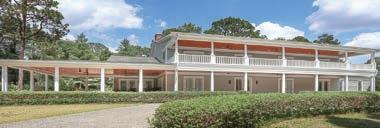
215 INVERRARY ROAD - FAIRWOODS ON 7
Privacy
$2,495,000
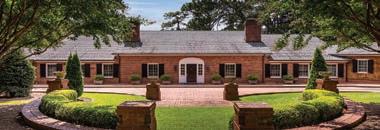
4 AUGUSTA WAY - PINEHURST
Charming, Historic, one of a kind Estate on over 2 acres. Gorgeous property, expansive patio across the back of the home overlooking terraced gardens leading to the Pond. An abundance of light-filled rooms, open kitchen, family room, detailed moldings throughout, fireplaces, hardwood floors, wine cellar, hunt room.
$1,850,000

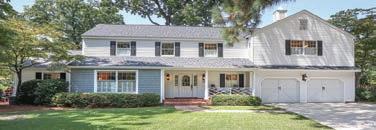
55 PALMETTO ROAD – PINEHURST
FULL VIEW OF PINEHURST NO 2, the famed Donald Ross masterpiece. Location with all the extras. Totally upgraded home, hardwood floors throughout, a handsome fireplace in the living room, separate dining room. Full kitchen opens to a bright family room with a fireplace and a wall of glass. Master bedroom on the first floor. Radiant heated floors in the second MB ensuite. Spacious climate controlled garage with cabinetry.

14 ROYAL COUNTY DOWN – PINEHURST NATIONAL NO 9
Immediate Pinehurst SIGNATURE Golf Membership for transfer with no “wait list” in the gated Community of Pinehurst National (Pinehurst No 9). Situated on the 13th hole on desirable Royal County Down, a tree lined street and one of the favorite streets in the Community. Immaculate move-in ready with over 3600 square feet of living space, chef’s kitchen, four ensuite bedrooms to include the Master and a guest room on the first floor. Stunning expansive “outdoor kitchen” recently added.
$1,350,000

110 SHORT ROAD
Charming


509 COTTAGE LANE - LONGLEAF CC
Soaring

The magic of the holidays is brought to life through the stories we tell and the experiences we share!
Holiday stories are told from generation to generation as a way to pass on our memories of this wonderful time of year. Join Weymouth Center for the Arts & Humanities for a weekend of enjoyment and wonder.
DECEMBER 6:
Candlelight & Carols 5:30 pm
Join us for a festive evening get-together
$50 members - $55 general admission
Tickets available at weymouthcenter.org
21 and up event
Childrens books donations accepted at entry!

Sponsored by Hubbard Dental

DECEMBER 7 & 8: Wonderfest & Market 10:00-5:00 pm
Tour the Boyd House decorated for the holidays, thrift holiday decor in the Holiday Shoppe, grab a treat and a warm drink from our Bake Shoppe, visit Santa, shop local vendors and artisans, enjoy popular area food trucks, watch live performances from local musicians and dancers. Fun for the Whole Family!
Donations accepted at entry!


Sponsored by FirstBank and Brooks & Grace Rentals
The Boyd House will remain open and available for self-guided tours and to see the decorations from December 9 - December 27.
Boyd House hours are Monday - Friday 10 am - 4 pm. Free and open to the public.

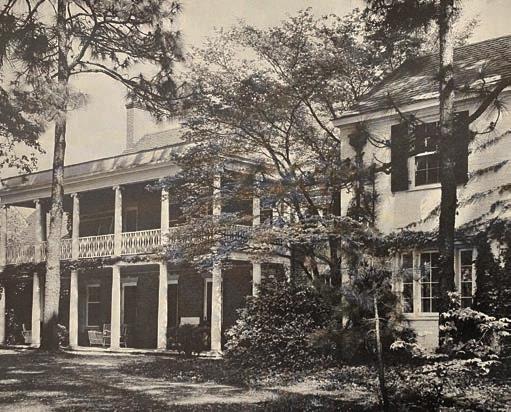

A paranormal dance of history & memory
October 23, 24, 25, 30, 31 and Nov. 1
6:00, 7:00, 8:00 pm Showtimes each night
Join the Weymouth Center for the Arts & Humanities for a supernatural and surprising evening of dance theater. Long Words; A paranormal Dance of History and Memory is a newly devised work of movement theater created for the community and premiering just in time for Halloween. Explore the history and legacy of James and Katharine Boyd, tour the historic grounds, hear terrifying tales of ghostly sorrow, and be inspired by the hidden history all around us. Audience members will move through the grounds and interact with performers as the stories of Weymouth come alive around them. Hurry, attendance and performances are limited!


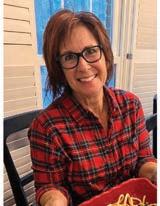
Wednesday, October 9, 11:30 am
Lunch and Learn: Italian
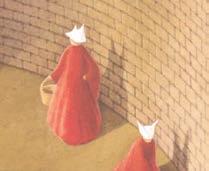





Warm up those vocal cords for the opening of the 18th season of the Metropolitan Opera at 1 p.m. on Saturday, Oct. 5, at the Sunrise Theater, 250 N.W. Broad St., Southern Pines. The kick-off is in a tavern in Nuremburg, the setting for Jacques Offenbach’s Les Contes d’Hoffmann. For additional information call (910) 692-3611 or go to www.sunrisetheater.com.

Judson Theatre Company presents Agatha Christie’s Murder on the Nile beginning Thursday, Oct. 17, at 7 p.m. at BPAC’s Owen’s Auditorium, 395 Airport Road, Pinehurst. The play is Christie’s own staging of her famous novel Death on the Nile, set on a paddle steamer cruising the Nile River in 1940s Egypt. The passengers aboard are abuzz when a famous heiress and her penniless new husband board the ship. There’s a spurned lover, a protective uncle, a troubled German doctor, and a host of colorful and mysterious characters adding drama and suspense to this classic mystery. Additional showtimes are: Friday, Oct. 18, at 8 p.m.; Saturday, Oct. 19, at 2 p.m. and 8 p.m.; and Sunday, Oct. 20, at 3 p.m. For information go to www.ticketmesandhills.com or to judsontheatre.com.


The penultimate First Friday of 2024 begins at 5 p.m. on Friday, Oct. 5, when Ashes & Arrows, a country/ rock band hailing from Asheville and Arrowtown — one in the mountains of North Carolina and the other a gold mining town on the South Island of New Zealand — takes the stage on the grassy knoll next to the Sunrise Theater, 250 N.W. Broad Street, Southern Pines. For information call (910) 692-3611 or visit www.sunrisetheater.com.

Pinehurst begins its Octoberfest celebration with Kinderfest from 4 p.m. to 6 p.m. on Saturday, Oct. 26, at Tufts Memorial Park, 1 Village Green Road W., Pinehurst. There will be music, crafts, a bubble artist and trick-or-treating among the participating village businesses. Then, when the kiddies are all worn out, the traditional Octoberfest activities break out from 6 p.m. to 9 p.m. For additional information go to www.vopnc.org.
The annual Holly Arts and Crafts Festival on the village streets of Pinehurst begins at 10 a.m. on Saturday, Oct. 19, and lasts until 4 p.m. or all the pottery, blown glass, stitched art, lawn ornaments, handcrafted jewelry, metal sculpture and pretty much anything else you can think of that someone can make with their own two hands is sold. If that’s not enough, the downtown shops will offer sales and specials. The address is 1 Village Green Road W., Pinehurst, but, like Savoir Faire, it’s everywhere. For info go to www.vopnc.org.

If It’s Halloween, It’s Rocky
And now for something completely different. There will be outdoor screenings of The Rocky Horror Picture Show on Friday, Oct. 25, and again on Saturday, Oct. 26, at 8:15 p.m. on the square beside the Sunrise Theater, 250 N.W. Broad St, Southern Pines. For information call (910) 692-3611 or go to www.sunrisetheater.com.


Prancing Horse will host its 33rd annual Horse Farm Tour from 11 a.m. to 4 p.m. on Sunday, Oct. 20. Guests take a self-guided tour of five of the finest equestrian facilities in the Sandhills. Tickets are $25 in advance and $30 on the day of. The address is Prancing Horse Tent, 6045 U.S. 1 N., Southern Pines and information can be found at www.ticketmesandhills.com.
The Moore Humane Society’s fundraising auction and gala will have a virtual auction, raffle, music and dinner on Friday, Nov. 1, from 6 p.m. to 9 p.m. at the Fair Barn, 200 Beulah Hill Road N., Pinehurst. Tickets are $125. For more info go to www.moorehumane.org.

The Carolina Philharmonic opens its 2024-25 season with a performance of “Eternal Echoes” featuring American pianist Rachel Breen and the power of Beethoven, the beauty of Smetana and the passion of Rachmaninoff at 7:30 p.m. at BPAC’s Owens Auditorium on Saturday, Oct. 26. For more information go to www.carolinaphil.org.

On Saturday, Nov. 2, from 7 p.m. to 10 p.m. the Moore Area Shag Society will host a fundraiser at Down Memory Lane, 161 Dawkins St., Aberdeen for the benefit of the Moore/Sandhills Coalition for Human Care. The music features the classic beach sound of The Embers with Craig Woolard. Tickets are $30 apiece and can be purchased by contacting Teresa Robinson (919) 622-2829.


Work both sides of the tracks when you trick-or-treat the downtown businesses in Southern Pines beginning at 5 p.m. and ending at 7 p.m. on Friday, Oct. 18. The evening includes hauling those bags full of candy to the Downtown Park, 145 S.E. Broad Street, Southern Pines, for Halloween games, crafts, activities and the best dog costume raffle. There’s no charge to get your multi-generational dress-up on. For more information call (910) 692-7376.

FirstMedicare Direct is hosting informational seminars at our Southern Pines offi ce October 1 – November 21. Learn about the Medicare Advantage plans available, how to enroll and more. Sessions are Tuesdays and Thursdays at 10 a.m and 2 p.m.
Go online to FirstMedicare.com/Events or call (877) 829-0251 (TTY 711) to RSVP and reserve your spot.
Available daily from 8 a.m. to 8 p.m. local time. Voicemail is used on holidays and weekends from April 1 to September 30.
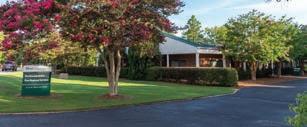

1930 N. Poplar St., Ste. 21 Southern Pines, NC


Scarlett Allison
Christine Barrett
Maureen Clark
Joy Blake Donat
Tracy Gibson
Keith Harris
Maribeth Hough
Laurie Kornegay
Ross Laton
Christian McCarthy
Melody Bell McClelland
Meredith Morski
Lesley Dacko Pacos
Caitlin Richardson
Brenda Sharpe

Kate Shinkwin
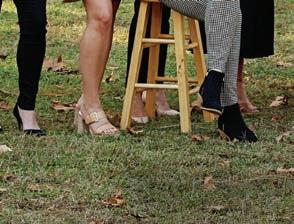









(September 23 –October 22)
When the shoe no longer fits, no amount of stretching or bending will change that. This year has given you loads of opportunities to release what no longer serves your highest path. And with the solar south node eclipse in your sign on October 2, suffice it to say that this month is going to be more of the same — uncomfortable yet, ultimately, liberating. A word of advice on moving forward: You’re going to want arch support.
Scorpio (October 23 – November 21)
Be the squeaky wheel.
Sagittarius (November 22 – December 21)
Dog-ear the page for later.
Capricorn (December 22 – January 19)
Best not to download the app.
Aquarius (January 20 – February 18)
Lie down if you start feeling dizzy.
Pisces (February 19 – March 20)
Hint: They can’t read your mind.
Aries (March 21 – April 19)
Book the trip.
Taurus (April 20 – May 20)
Bypass the candy corn.
Gemini (May 21 – June 20)
It’s time to call the shots.
Cancer (June 21 – July 22)
Write a love note to yourself.
Leo (July 23 – August 22)
Prepare for liftoff.
Virgo (August 23 – September 22
Sometimes more is more. PS
Zora Stellanova has been divining with tea leaves since Game of Thrones’ Starbucks cup mishap of 2019. While she’s not exactly a medium, she’s far from average. She lives in the N.C. foothills with her Sphynx cat, Lyla.









by a nne blythe
Ever wonder what it takes to make a good relationship great or how to keep a great relationship from becoming average?
Frances Mayes, author of Under the Tuscan Sun, gingerly guides readers through such questions, and more, about the nature of relationships in her new novel, A Great Marriage.


The 84-year-old author has generated an extensive list of bestsellers in the nearly two decades since her memoir about purchasing, restoring and living in an Italian villa became the basis for a Hollywood movie starring Diane Lane. Her forte — travel and food writing — is evident in A Great Marriage, a love story based largely in fictional Hillston, a North Carolina town with similarities to Hillsborough, where Mayes and her husband spent many years in a historic home along the Eno River.
Whether it’s through a Lowcountry seafood boil on fictional Indigo Island, a pub meal, too much Scotch on a drunken night in London or accounts of homes, streetscapes and waterscapes scattered throughout North Carolina, South Carolina, New York, San Francisco and London, Mayes’ descriptions
have transportive power.
have transportive power.
A Great Marriage opens in Hillston at a lavish dinner party celebrating the whirlwind romance and engagement of Dara Wilcox, a wellto-do aspiring law student who grew up in the quaint town, and Austin Clarke, an aff able young British architect working temporarily in New York. The two met at a New York art gallery when Dara was visiting from Washington, D.C., for the weekend.
“They looked at the contorted, deflated gray balloons glued to a manhole cover for a full minute, then at each other,” Mayes wrote. “They started laughing.”
While it depends on which character is doing the storytelling to be sure who picked up whom, there’s no question that Austin and Dara are drawn almost instantaneously to each other. They fall feverishly in love, determined to make their lives together work even though they live in different cities and are at different stages professionally.
When a glass of red wine is spilled at the bountiful meal Dara’s parents prepare for their spirited daughter, her genial and well-mannered fiancé, friends and family, it does more than make a mess. Not only does the wine stain the white tablecloth and napkins, it splashes onto Austin — and portends turmoil ahead.
Shortly after that night, Austin gets tumultuous news from


The Carolina Philharmonic’s 2024/25 Concert Season





Maestro David Michael Wolff leads The Carolina Philharmonic Orchestra through a symphonic celebration of Beethoven’s power, Smetana’s beauty and Rachmaninoff’s passion in his epic Piano Concerto No. 3, featuring the emerging American pianist, Rachel Breen.
Saturday, October 26, 2024 | 7:30pm Owens Auditorium, SCC
Reserve your seat today!

London that changes his life and the trajectory of the romance that had seemed destined for the wedding aisle. He’s about to be a father. Adding more drama to the mix, the mother-to-be of the child conceived after a night of heavy Scotch drinking has a potentially fatal medical condition.
Suddenly the engagement is off.
Austin moves back to London, unsure of what fatherhood will look like for him.
Dara is gobsmacked and seeks solace from her parents in North Carolina, her grandmother on the South Carolina coast, her good friends in San Francisco, and a crew of artists with whom she spends a summer helping to give new life to an old seaside motel.
There’s an assemblage of characters that Dara and Austin call on as they go their separate ways; some better fleshed out than others. We meet many of them in the opening pages during the engagement celebration, but sometimes it can be difficult to take them all in. It can feel as though you’re at a dinner party where you barely know the hosts or the guests and you’re constantly trying to figure out how theyʼre connected to one another.
Stick with it. As the story unfolds, the connections become clearer and it’s easier to distinguish the incidental characters from those who are key to the plot line.
Dara’s mother, Lee, a university professor in Chapel Hill who spent her career writing a book about William Butler Yeats, and her father, Rich, a journalist who gets plum travel assignments,




have one of those marriages that seems in balance. Dara’s grandmother Charlotte, or Mimi, as she calls her, has had more than one marriage, but is so well-versed in the trials and tribulations of the institution that she has written two books on the subject
— The Good Marriage, which sold millions of copies; and The Good Divorce: It’s Never Too Late, also a bestseller. Austin’s father, Michael, and his sister, Annsley, are booksellers in London who come to his rescue as he ponders life without Dara.
Life lessons are dished up throughout the book about the meaning of marital vows and what makes a great marriage. Mayes is deft at showing the many angles of the predicaments Austin and Dara have found themselves in, making it possible for readers to empathize with each one.
Some might find it difficult at times to relate to Dara, who has the freedom to stay with friends for weeks at a time and travel here and there, seemingly without responsibility. There’s a bit of a fairy tale feel to the book.
But if you’re in the mood for some armchair travel and a glimpse into a world where people have the luxury of hopping across a country or an ocean in search of happiness, A Great Marriage offers a great escape. PS
Anne Blythe has been a reporter in North Carolina for more than three decades covering city halls, higher education, the courts, crime, hurricanes, ice storms, droughts, floods, college sports, health care and many wonderful characters who make this state such an interesting place.




















Brightly Shining, by Ingvild Rishoi


Christmas is just around the corner, and Ronja and Melissa’s dreamer of a father is out of work again. When 10-year-old Ronja hears about a job at a Christmas tree stand near where the family lives in central Oslo, she thinks it might be the stroke of luck they all need. Soon, the fridge fills with food, and their father returns home with money in his pocket and a smile on his face. But one evening he disappears into the night under the pretense of buying Christmas gifts — and his daughters know he has gone to his favorite local pub, Stargate. Melissa decides to take his place at the Christmas tree stand, working before and after school in the December dark, and brings along Ronja, who quickly charms all the middle-class customers. The sisters dream of a brighter place of kindness and find help from some of those around them in this story that has all the markings of a magical modern classic.
Laura Imai Messina
On the peaceful Japanese island of Teshima there is a library of heartbeats, a place where the heartbeats of visitors from all around the world are collected. In this small, isolated building, the heartbeats of people who are still alive or have already passed away continue to echo. Several miles away, in the ancient city of Kamakura, two lonely souls meet: Shuichi, a 40-year-old illustrator who returns to his hometown to fi x up the house of his recently deceased mother, and 8-year-old Kenta, a child who wanders like a shadow around Shuichi’s house. Day by day, the trust between Shuichi and Kenta grows, until they discover they share a bond that will tie them together for life. Enchanting, touching and emotionally riveting The Library of Heartbeats is a




story about loss and hope, pain and joy, reality and imagination, and the promise of healing and overcoming the odds.
Trails & Treats: A Hiker and Runner’s Guide To Great Trails and Good Eats In North Carolina, by Palmer McIntyre and Hollis Oberlies
Want to step out of the old routine and discover the beautiful landscapes of North Carolina? Trails & Treats describes 30 trails across the state, broken down into four geographical areas: the Triad, Triangle, Mountain and Charlotte regions. Not only does the book provide the distance of each trail and level of difficulty for hikers or runners, in it are recommendations for the restaurants, coffee shops, local markets and picnic areas that are worth a visit before or after the workout. A great read for seasoned hikers and runners or first-time explorers.
The Name of This Band is R.E.M: A Biography, by Peter Ames Carlin
In the spring of 1980, an unexpected group of musical eccentrics came together to play their very first performance at a college party in Athens, Georgia. Within a few short years, they had taken over the world with smash records like Out of Time, Automatic for the People, Monster and Green. Raw, outrageous and expressive, R.E.M.’s distinctive musical flair was unmatched, and a string of mega-successes solidified them as generational spokesmen. In this rich, intimate biography, Carlin looks beyond the sex, drugs and rock ’n’ roll to open a window into the fascinating lives of four college friends —Michael Stipe, Peter Buck, Mike Mills and Bill Berry — who stuck together at any cost, until the end.

Still Life, by Alex London
Of course, just when you finish creating your still life, a dragon has to jump in to stir things up! Art meets fantasy in this laugh-out-loud picture book. This one is perfect for that kid who loves jokes, riddles and a little sarcasm. (Ages 4-6.)
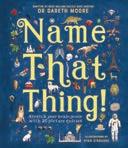



Name That Thing! by Gareth Moore
How many sports can you name with just the balls as clues? How many dinosaurs from just their nicknames? How many buildings from only the shape? How many dogs from their original jobs? Name That Thing! is a fun-fact quiz book for that inquisitive kid — and equally interested grownup — to investigate together. (Ages 6-12.)
The Café at the Edge of the Woods, by Mikey Please
Fans of Julia’s House for Lost Creatures will delight in this charming, off beat foodie tale with a sprinkle of adventure, a side order of friendship and — oh, yeah — ogres. This one is sure to be a hit with kids who want to giggle, and adults who are game to try pickled bat and slug fondue. (Ages 4-8.)
When We Flew Away, by Alice Hoffman




The ’40s gave us the Diary of a Young Girl, written by Anne Frank. In the ’50s, it became a movie, and in the 2000s a Netflix adaptation. Each succeeding generation searches for more of Anne’s story. When We Flew Away imagines Anne before the diary — the apple of her daddy’s eye, a girl with friends and a sometimes-pesky little sister, but mostly, just a girl. This important book is sure to be on the top of readers’ stacks this fall. (Ages 12 and up.)
The Last Dragon on Mars, by Scott Reintgen
Danger, fast-paced chases, secret underground military agencies, and an unexpected dragon named Doom — what more do you need? A classic adventure story, The Last Dragon on Mars is the book we’ve been waiting for. (Ages 12 and up.) PS
Compiled by Kimberly Daniels Taws and Angie Tally


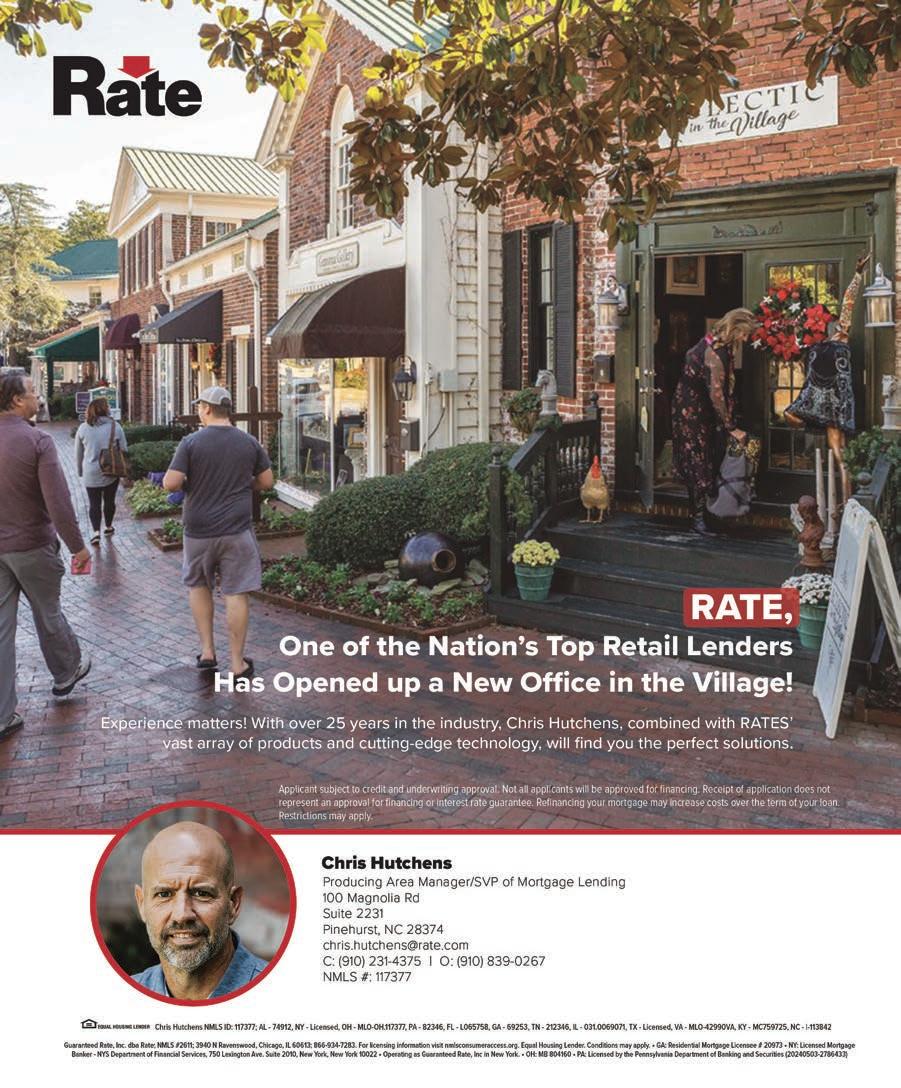


by bIll FIeldS

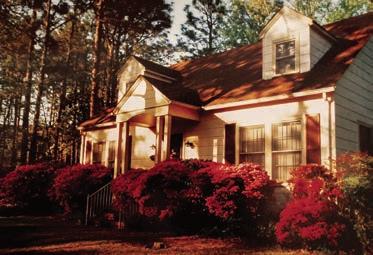
On a rainy afternoon not long ago, I drove by my childhood home not far from downtown Southern Pines. An old friend was with me, someone who also had grown up in town when it was its former drowsy and piney self, when “a sophisticated Mayberry” was an apt description of the place where we were lucky to live, those days now as distant as rotary phones and drugstore orangeades.
We pulled over to the curb, on the north side of the property and then on the east, our conversation seeming to take on the rhythm of the rental car’s intermittent wipers. It was easier to talk about the focus of the visit, a 1950s Cape Cod that held so much family history, than see it, which is why we assumed a couple of different vantage points and why, for me, this has been a rare excursion.
The original structure endures, but it takes some effort to get a glimpse of it, given that it’s surrounded by three “cottages” constructed on the property after we sold, one of them tall and painted a gray so dark it is nearly black. Our former five-bedroom residence is overwhelmed by the looming houses, making it seem like a shed out back of someone’s mansion.
My parents bought our home a handful of years before I was born in 1959. They had been living in Pinedene, close to Mt. Hope Cemetery. When the Highway 1 bypass was being built through their neighborhood, they were forced to move. About 10 years ago, when my mother was in her early 90s, she was in a car with me on a side street not far from the old Lob Steer Inn.
“There’s our old house,” she said.
I thought her mind was playing tricks, but I subsequently confirmed that the Pinedene house wasn’t torn down but relo-
cated to where Mom said it was. While some other family settled in there, my parents and two sisters moved to their new home. My siblings were off to college and their adult lives less than a decade after moving there, but 390 East New Jersey was my only address growing up.
That fact, as well as maintaining closer ties to our hometown through the years, is why I felt a closer attachment to our house than my sisters did. But we all found pleasure in being able to return there for a long time, perhaps too long if we’re being honest. Increasingly stubborn in old age, when her cognitive decline made things difficult and dangerous, Mom didn’t want to leave for a safer environment.
I won’t forget that day in 2017 when I walked her out the back door for the last time, toward the car and on to an assisted living facility. I would turn that lock dozens more times until the house wasn’t ours anymore. On those visits, I didn’t miss the volume on the television being set to a nonagenarian-without-hearing-aids level. It was nice to put a six-pack on the top shelf of the refrigerator instead of burying it in the vegetable drawer. How, though, I wished she was still there, sitting on her screened-in patio that she enjoyed so much, in a wicker chair that had been on her mother’s porch, azaleas and robins the sights and sounds beyond her favorite oasis.
It had been a home, not a house. As my friend and I chatted in the car so near yet so far from that memory, I was reminded of that.
I suppose I’m glad the structure still stands in its renovated form — that the walls that contained our hopes and fears weren’t demolished — but I will never go inside again. What went on in and around that home lives in my interior, easily recalled, the view unobstructed. PS
Southern Pines native Bill Fields, who writes about golf and other things, moved north in 1986 but hasn’t lost his accent.




































A pint of the occult, please,
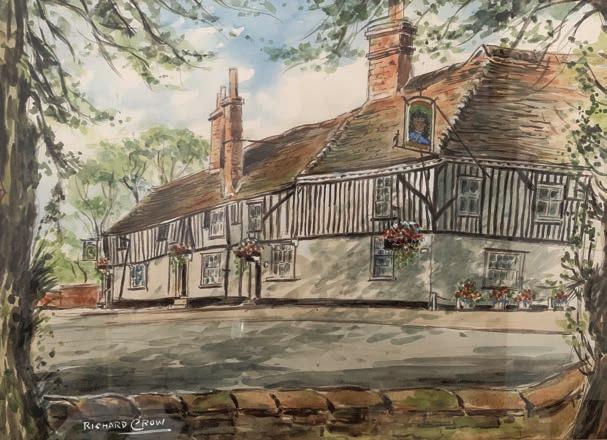
by tony rothwell
to the east through the beautiful rolling countryside of Essex, you may come across Dedham, a medieval village on the banks of the River Stour. There are a few shops, a handsome church, and a prominent black and white building, the Marlborough Head Hotel. Built in 1495 for a wool merchant, it was first an apothecary and then, in 1704, converted to an inn. The Duke of Marlborough (a forebear of Winston Churchill) was the hero of the day after a number of successful battles in Europe, so it was fitting that the inn should bear his name.
In November 1970, the phone rang at the inn, and a caller with an American accent booked two single rooms. The guests,
a man and a woman, arrived at the Marlborough in the early evening and, after settling in, came down to the bar for a drink. Nothing unusual so far. My father, who owned the inn, was filling in behind the bar because Flip, the barmaid, was late.
The man told Dad he was a journalist, sent by Esquire magazine to write an article on English ghosts. He introduced his companion as a medium from the College for Psychical Research in London. They had heard about a ghost sighting in the village and asked my father what he knew about it.
Over the 500-plus years, thousands of stories must have been told in Marlborough’s bar; certainly the inn’s creaking, uneven floorboards, centuries-old beams, huge fireplaces and hidden passages made it the perfect setting for a ghost story.
Dad told them that the previous Saturday night, Halloween, a regular named Phil was walking home in the dark after several pints, and the last thing he remembered before collapsing to the ground was a ghost appearing in front of him. Passersby saw him lying in the road, dead to the world, and carried him back to the inn, where Dad ministered brandy. When he revived, Phil de-






scribed seeing a white apparition, arms outstretched, screeching. There was major skepticism in the village about the story, given the alcoholic intake of the storyteller, but it made regional news anyway, and somehow word reached the wider world. The man from Esquire — as luck would have it, already in London — hightailed it out with his medium in tow to investigate. It was, after all, a hot lead.
As Dad told the story, the lady took off her jacket, saying she was getting very warm and was “probably going into a trance ”
The London medium started telling Dad his life story — eerily accurate in its detail — including, among other things, that he had two sons, Bill and Tony. But, she said, she was sensing a third name. Charlie.
My elder brother, Bill, got the nickname Charlie when he went away to boarding school, and when I, Tony, followed him to the same school four years later, the nickname transferred to me. There was one other thing: There would be a marriage in the family which would involve someone from Beckenham. As I was the only unmarried person in the family at that point, I took particular interest when Dad passed this bit of information on to me!
Soon the ghost-sighting story started to lose steam. It came out that some village lads had been responsible for the whole thing. They knew Phil always walked home on a Saturday evening around 11 o’clock — following the announcement of “Time gentlemen please!” — and the village, having no streetlights, would be perfect for a big, white-sheeted apparition rising out of the dark. That their prank would go “viral,” or what passed for it in those days, was strictly a bonus.
A year or so later, when I was working in London for a hotel company, I began falling for a very pretty girl, Camilla. We started going out and occasionally went down to her parents’ house in Sussex for the weekend, about 50 miles south of the city. One evening we set out on our usual route but the rushhour traffic was solid, so Camilla suggested a different way. As we drove through this unknown-to-me territory, I asked where we were. Camilla replied, “Beckenham. We used to live here.” The car swerved a little.
“Did you say Beckenham?” I asked.
“Yes,” she answered, “I’ll show you the house where I grew up.”
I kept the medium’s prediction — now a bit of family lore divined across the bar in the Marlborough Head Hotel — to myself until after we were engaged, now some 52 wedding anniversaries ago. And all because Flip the barmaid was late for work.
Neither the barmaid nor the medium was invited to the wedding — but the story certainly made it. PS
Tony Rothwell, a Brit, came over to Washington, D.C., to work in the hotel industry in 1987 and moved to Pinehurst with his bride, Camilla, several years ago. He sings in the Moore County Choral Society and plays golf but reports that while his voice is getting lower his handicap is headed in the other direction. He can be reached at ajrothwell@gmail.com.
Every












by lIZa robertS
Christina Lorena Weisner’s art emerges from her deep connection to the earth, to its systems and rhythms, its elements and mysteries. She studies the planet like a scientist and discovers it like an explorer, venturing to its far ends to record its extremes in person, to live within its phenomena. She turns her insights into art she hopes will inspire awe for our planet’s grandeur and empathy for its vulnerability.
Her latest fascination is the North Pole, where she spent two weeks immersing herself last spring with an expeditionary art and science residency called The Arctic Circle. “I can only describe it as the most impactful experience of my life,” Weisner says. “I’ve been interested in water for a long time, and I wanted to immerse myself into this landscape of glaciers in order to better understand it.”
The expedition’s ship, which carried 30 fellow resident artists and scientists, took Weisner and others to the Svalbard Archipelago by outboard Zodiacs twice a day, always surrounded by “a triangulation of guards with guns” to protect them against polar bears. While ashore, Weisner planted an orange safety flag in the icescape, making it a recurring motif in her


photos. She also used a drone to shoot video from above and collected plastic.
“You’re in a land that you know is changing, you’re looking at a glacier that might not be there in 100 years. You’re looking at history,” she says. That history was evident in other ways, too, like a massive pile of whale bones left behind by 19th century whalers, and the detritus left behind by scientific explorers of that time. “There were many instances where I was thinking of human history as it relates to geological time,” Weisner says.
The trip “was the catalyst for a whole new body of work,” says Weisner, who is headed back next May. That work includes still photography of that mythic frontier, sweeping video and installations that incorporate pieces of plastic she collected in and around Svalbard.
Recently, her work was in Surface and Undercurrents, a group show at Dare Arts in Manteo, and this month she is part of a group exhibit at Emerge Gallery & Art Center in Greenville. Next April she will be featured in a group show at Central Connecticut State University on climate change in the Arctic, and in June her work will be exhibited in a solo show at the Museum of Contemporary Art in Arlington, Virginia.
A native of Richmond, Virginia, Weisner says she can trace the beginnings of her work as an artist to a job she had with
Nag’s Head Ocean Rescue in her early 20s. When she wasn’t saving swimmers, she stared out at the ocean for 10 hours a day. “I would watch the sun move across the sky and the moon come up,” she says. “I was very aware of these bigger processes — these large-scale movements, like waves coming over from the coast of Africa — that we’re not often aware of.”
Other little-seen influences in her work come from her wide-ranging education, which includes an MFA from University of Texas at Austin and separate undergraduate degrees in both world studies and fine arts from Virginia Commonwealth University. The interplay between humans, time and the planet has long been a theme in her work. As a former competitive swimmer and regular runner and biker, she experiences the world in a visceral way, creating art that is informed by the way we live within the world and the way the world lives with us.

From her home in Kitty Hawk (she’s soon to move to Duck, two Outer Banks towns away), Weisner rides a bike or runs along the beach every day to note its transformations. “It’s the
same beach, but it’s completely different, the water color, the form of the waves, the temperature of the wind,” she says. Sometimes she finds objects to incorporate into sculpture as she goes.
Waves and wavelengths — audio, seismic and light — all inspire her. A meteorite impact crater in Southern Germany was the subject of sculpture and installation art she created with the Fulbright Grant she was awarded in 2013; she used seismometers to record earthquakes as part of a Mint Museum installation in 2018.
One early morning in March 2022, I had the chance to witness her in action. On the shores of Kitty Hawk Sound, I watched as she zipped up her wetsuit, assembled a series of floating sculptures, and waded with them into the frigid waters. The sun wasn’t fully up, the air was barely 40 degrees and the art she was wrangling was bigger than she was. Weisner took it all in stride. In a matter of minutes, she’d glided 50 yards from shore and her art was floating all around her.
The largest of the three pieces of art with her that morning was one she’d attached to her outrigger kayak and towed 275






miles down parts of the Eno and Neuse Rivers and through the Ocracoke Inlet in 2019, recording audiovisual information and environmental data (including a panther sighting) along the way. Two smaller works included discarded beach chairs from one of her regular oceanside jogs.
Her approach with every subject, Weisner says, is to embrace what she doesn’t know, and to let her new knowledge as well as her material guide her.

“I’m still a process-oriented artist,” she says, one focused on “openness to material and play, not taking my work too seriously . . . and not being too pigeonholed.” She thrives when she can employ all of her senses in the making of her art, especially work that involves nature. And she loves making connections across time and place.
When the polar vortex winds of 2022 washed an old canoe up on the side of the road near her house, for instance, she picked it up and brought it home.
“It had beautiful layering on it,” she says. “The water had rotted holes into it. I think it had been submerged in the sound for a couple of years.”
The fact that winds from the Arctic dislodged it and brought it to her North Carolina shore fascinated her, she says, and that canoe has become part of her latest Arctic-inspired installations. “No place is an isolated place,” says Weisner. “Everything we do — everything that happens in one geographic location — impacts other geographic locations.” PS
This is an excerpt from Art of the State: Celebrating the Art of North Carolina, published by UNC Press.



know that when life gets demanding, home-cooked meals are few and far between, and ordering out can add up quickly.
Don’t break the bank ...
A FAMILY
your choice of scratch made Entrée, 2 Large Sides and 6 Signature Yeast Rolls.









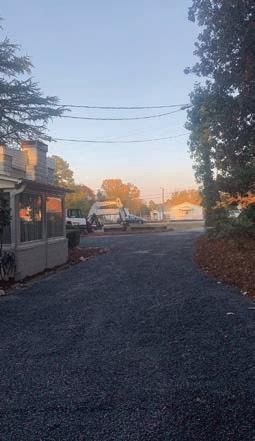
Story and P hotograPh by tony CroSS
Amanda Schuster’s Signature Cocktails is a beautiful cocktail recipe book that pays homage to older cocktails, as well as those that will be soon. I’ve been in the process of mentally preparing myself for a brick and mortar bar of my own, and every now and then I come across a drink that I visualize serving in my fantasy lounge. “Big Trouble in Oaxaca” is one of them, courtesy of Schuster’s book.
The name of the drink pays homage to the ’80s movie Big
Trouble in Little China. It’s essentially a riff on a margarita, and what first got my attention is how it glowed on the page. Bright and fluorescent, its hue reminds me of when I’ve had one too many B vitamins . . . if you know, you know. Created in 2018 at the restaurant Drink Kong by bartender Livio Morena, this cocktail seems to fit the bar’s trademark ’70s and ’80s nostalgic theme. The neon color comes courtesy of Midori melon liqueur (which was first popular in the late 1970s) and was used “because in 2018 it just seemed so dated and weird that it might be the perfect way to attract attention to the bar, and also show love for Japanese culture,” says Morena.
Personally, I can see this drink catching the eye of anyone in a dimly lit cocktail lounge. The fact that it tastes amazing only solidifies the odds of me serving this one night as a drink special. Hypothetically, of course.

SPECIFICATIONS
1 1/2 ounces tequila blanco
3/4 ounce pineapple liqueur
1/2 ounce Midori liqueur
1/2 ounce green ancho chili liqueur
1 ounce fresh lemon juice
1/2 ounce sugar
EXECUTION
Combine all ingredients in a cocktail shaker, add ice and shake hard for 10 seconds. Strain into a chilled rocks glass over a large cube. No garnish. PS

Story and P hotogra Ph by roSe Shewey
On All Hallows’ Eve, I want to be spooked, not nauseated. Every year, I cringe at the sight of gory Halloween paraphernalia. A matter of personal preference? Perhaps. Now that we are parents to a young child, I have mixed feelings about terrifying the innocent. No trick-or-treater should be scarred for life by a 10-foot-tall disemboweled animatronic zombie reaching for him as he walks up the sidewalk with a bag full of candy wearing a pumpkin suit. What’s wrong with the triedand-true classics, like black cats, friendly ghosts and cackling witches?
This goes for food as well. In all my recipe-developing, food-styling and photographing years, I have successfully dodged making ghoulish treats for Halloween, goodies as ghastly as cream cheese stuffed “roach” dates, or zombie brain Jell-O shots. Thanks, but no thanks. Esthetics do matter. Unless you have lost a bet, you should not be subjected to red velvet brain cake, or worse — and it can get much worse. So let’s move on to a delightfully, frightfully, whimsical Halloween the whole family can enjoy.
For my part, I’m planning on casting a spell on my All Hallows’ Eve tablescape with chai spiced candy apples — no artificial dye needed, unless you want a deep crimson. I quite like the natural, organic glow of these apples, which retain coloring from the rooibos tea. I have also tested these with natural food coloring, which worked well enough. Keep in mind that at 300 degrees Fahrenheit — the required temperature to create a hard candy shell — most natural dyes fade; some more, some less. If you use red apples (pick your favorite variety), you might fall in love with the naturally tinted, glossy and traditional look of these slightly haunted — but not too much — candy apples. PS
German native Rose Shewey is a food stylist and food photographer. To see more of her work visit her website, suessholz.com.
Makes 6
6 apples
400 grams (about 2 cups) granulated sugar
240 milliliters freshly brewed rooibos tea, or filtered water
1/2 teaspoon ground chai masala
1 teaspoon freshly squeezed lemon juice (to avoid crystallization)
Optional: India Tree red liquid food color (all natural)
For best results, make sure your apples are unwaxed or remove wax prior to making the candy by dipping apples into boiling hot water for 5-10 seconds, then wipe off wax immediately with a kitchen towel. Apples may turn brown from this procedure but wax could cause unsightly air bubbles in the candy shell, so use this method as needed. Make sure your apples are completely dry, twist off stems and insert lollipop sticks or small but sturdy wood sticks. In a mediumsmall pot combine all ingredients (except for food coloring, if using) and slowly heat the mixture until it comes to a boil. Allow the sugar to boil gently until the mixture turns an amber color or a thermometer registers 300 degrees Fahrenheit — the hard crack stage. Turn off heat and immediately add food coloring and start dipping apples. Set apples on parchment or wax paper until the candy shell has completely hardened. Store in the refrigerator.



by deborah Salomon
October. Not a mellifluous word. Unlike April, May and June, not a name for a baby girl, either. But oh-so-welcome.
Looking through hundreds of columns from a dozen publications, I see a pattern: In my life, seasons call the shots, index the memories. Subjects range from Cape Cod Julys with three kids and a cranky basset hound to skiing in March, when a warm sun turns powder to slush. May means dreaded hay fever. Gray, raw November finds Tom turkey thawing on the screened porch. August is when denim blue ring binders and black and white-splattered composition books fi ll the stores.
But for me, the most beautiful, the only perfect month, is October — even though here, the feel of October may not arrive until the calendar says it’s the early days of November. I’ll know it’s October because one morning I’ll wake up to air squeezed dry of humidity and temps beginning with a 5, not a 7. The afternoon sun may fall low on the horizon but our pines don’t respond by turning a New England red, yellow and orange.
Years ago, I found one scrawny maple bordering Dollar Tree on Brucewood Drive. Its few leaves were bright red. I make a pilgrimage to it every October.
These autumn allusions result from living most of my life in New York, Vermont and Canada — also Asheville, which puts forth a decent October although nothing as pungent as MacIntosh apples being pressed into cider. The finest French pastry cannot compete with October’s first cider doughnut. But watch out. Every rose has a thorn. This process attracts yellow
jackets eager for a last sting before the first frost.
Without October, hooded sweatshirts would be superfluous: too hot for September, not warm enough for November. All summer I daydream about fleece against bare skin. That and football, from the days my son was the high-scoring running back on his high school team. Otherwise I’m cool on football — a brutal sport, difficult to understand, painted in mud, blood and sweat on the evergreen turf.
Corduroy and flannel appear on autumn’s fashion runway. Nobody rakes leaves in Yves Saint Laurent.
October, I’ve noticed, reverses summer’s deleterious effect on appetites. Soup and stew reappear with chewy sourdough for dunking. Oatmeal regains its stature, in bowls and cookies. Beer is celebrated, as though it needs a fest. After months of grilling, cooks fire up the oven for a meatloaf to create thick sandwiches on rye for Saturday’s tailgate with real football folks.
I looked up holidays assigned to October; most are silly and commercial except for National Breast Cancer Awareness Month, when pink rivals Halloween orange and black. One year KitchenAid marketed a bright pink stand mixer.
In colder climates October stands as the bittersweet portal to winter. Not here, where golf is played on Christmas Day and nobody buys snow tires. But to me, month number 10 will forever remain the glorious conclusion, the reward for surviving June, July and August when the electric bill is more dreaded, even, than the bugs.
So, once again, welcome, October. I am so ready. PS
Deborah Salomon is a contributing writer for PineStraw and The Pilot. She may be reached at debsalomon@nc.rr.com.








• ALL-NEW AMISH-MADE DOORS, DRAWER FRONTS
• 1/4” SOLID WOOD FACING
• NEARLY UNLIMITED COMBINATIONS OF WOOD, STYLE, COLOR OR FINISH
• MODIFY & CUSTOMIZE: CHANGE, EXTEND, ADD
• INSTALL DRAWER BANKS, ROLL-OUTS, AND MORE




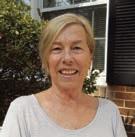


by SuSan CamPbell

Listen . . . an eerie trill or spooky shriek from out of the darkness at this time of year just might indicate the presence of an eastern screech-owl. Territorial adults readily use a mix of screams, tremolos with different pitches and long trills to advertise the boundaries of their home range. Their vocalizations are remarkably loud for such small birds: Screech-owls only stand about 8 inches high. They can be found in forests all over North Carolina, especially in thick pine stands, so much of our Piedmont habitat is great for them. Furthermore, they are with us year-round.
Eastern screech-owls can be either a dull gray or a rich rufous color. Dark splotches and vertical striping on the breast and belly provide excellent camouflage against tree bark, where they can be found roosting during daylight hours. Tufts of feathers on the head give an eared or horned appearance. They may be sitting close to a tree trunk or peering out of a cavity. As is the case with most raptors, females are larger than males. Nonetheless, females have higher pitched calls. Rarely are they seen, unless crows or flocks of songbirds signal their presence by frenzied flight and raucous calling.
This species is found throughout the eastern United States as well as along the Canadian border and in easternmost Mexico. Although they may wander somewhat outside of the breeding season, eastern screech-owls are not migratory. These diminutive owls breed in the springtime. Pairs, who usually stay together for life, nest in cavities, utilizing old squirrel or woodpecker holes as well as purple martin houses and wood duck boxes. Not surprisingly, pairs of screech-owls will readily take to boxes made to their exact speci-
fications. A female simply lays up to six white eggs on the substrate at the bottom of the cavity. Incubation takes about a month, and then the young birds take another month to develop before they fledge. During this period, while the female remains on the nest, her mate will hunt nightly for the growing family.
Eastern screech-owls eat a wide variety of prey. Rodents are a large portion of their diet, but they also readily catch frogs, large insects and other invertebrates, including crayfish and even earthworms. They have been known to feed on roosting birds and the occasional bat. Screech-owls are very much at home feeding on mice, rats or voles that can be found around bird feeders at night — as well as moths and beetles attracted to outside lights. These birds adopt a “sit-andwait” strategy, then pounce on their prey and swallow it whole. Owl gizzards are specially adapted to digest the soft parts of the creatures they eat and then ball up the bones, fur and other indigestible bits into an oval mass that is regurgitated each day. Favored roost sites or nest cavities can be found by locating piles of these masses (or pellets, as they are referred to) on the forest floor. Unfortunately, screech-owls often hunt along roadsides and are prone to being hit by cars as they swoop low over the pavement to grab a meal.
Overall, however, eastern screech-owls are a successful species that has adapted well to the changes humans have made to the landscape. In fact, urban individuals tend to be more successful than their suburban counterparts, likely due to several factors, including fewer predators, more available prey and plenty of cavities in the landscape. So, spend some time outside after dark and train your ears for the trill or tremolos of our eastern screech-owl. No doubt there are one or two living in your neighborhood. These cute little birds are anything but scary once you get to know them. PS
Susan Campbell would love to receive your wildlife sightings and photos. She can be contacted by email at susan@ncaves.com, or by calling (910) 585-0574.























Some animals have a serious image problem and are in dire need of a better PR person. Take snakes, for example. Most people fear them. Many despise them. Lots hate them. Ditto for spiders. And don’t get me started on wasps. Sharks were, until recently, feared and loathed as much as any animal. Today, due in large part to the popularity of “Shark Week” on the Discovery Channel and social media campaigns by nongovernmental organizations like the
Atlantic White Shark Conservancy and Ocearch (each with hundreds of thousands, if not millions, of followers), the tide is turning for these toothy predators. Many people find them fascinating and donate hard-earned cash to protect them for future generations to enjoy. Heck, a few years back on Cape Cod, a dozen vacationers enjoying a summer day at the beach rallied to help save a young great white shark stuck on the sand during an outgoing tide. They poured water over its head and gills until a boater was able to tie a rope around its tail and drag it into deeper water, where it swam away of its own accord. A video of that event went viral and racked up millions of views.
Bats, by any measure, are right up there with snakes,







Framed Art is the Centerpiece of your Home
Accent your walls with reflections of your unique style through the unlimited custom picture framing design choices at The King’s Custom Framing.
• Honor that Special Occasion wrapped in a Custom Frame
• Preserve Great Golfing Moments
• Protect and Display Special Military Achievements and Memories Create the perfect frame design for the things you love.









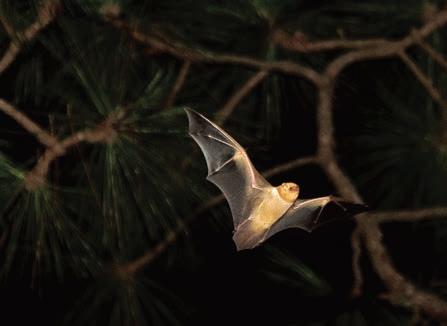
spiders and wasps on the unlikeable scale for much of the human population, perhaps due to their secretive nocturnal habits. Bats carry an aura of the supernatural and have long been staples in the annals of horror literature and cinema. Worldwide, they are the subject of myth and folklore. Many people fear bats as carriers of disease that will attack at any given opportunity. Granted, some individual bats can be infected with a disease such as rabies, but it is important to keep things in perspective. Far more people are bitten by rabid dogs in a given year than by rabid bats. And consider this: Beavers can carry rabies as well. Yet most people don’t fear beavers.
Bats are among our most fascinating and beneficial animals. All 17 species of bat that have been recorded in North Carolina are avid consumers of insects. Studies have shown that they eat millions of tons of insects each and every night, many of them agricultural pests. Without bats flying about the landscape, farmers would need to spend millions more dollars on pesticides.
One North Carolina bat in particular has recently captured my imagination. It all started last summer when I was sitting out in a patch of ironweed growing in the heart of the Sandhills Gameland trying to photograph sphinx moths at dusk. The moths would appear like clockwork just as the sun dipped down over the pines, hovering over the vibrant purple flowers of the ironweed like nocturnal hummingbirds.
Around the same time, several eastern red bats could be seen flying high over the ironweed patch, their velvety wings silhouetted
against the golden-hued sky. With 4-inch-long bodies and wing spans just shy of a foot, the bats were not much larger than the moths. Their swooping flights over the tree canopy as they chased insects, including the sphinx moths, was mesmerizing.
As the planet’s only true flying mammals, bats are evolutionary marvels. With nearly 1,400 species recognized by scientists, bats are found across the globe, occupying all the continents except Antarctica.
True to their name, red bats are indeed gingers. With bright reddish orange fur coats, especially prevalent in males, red bats are strikingly beautiful.
Unlike most of our other native bat species, red bats tend to lead solitary lives and are not particularly social. I can relate. This quirk of their personality has saved them from a deadly fungal infection that has drastically reduced populations of their more communal cousins. The infection, known as white-nosed syndrome, has wiped out millions of bats across North America and is widely considered to be among the worst wildlife diseases in modern times.
If you step outside in the Sandhills on most summer evenings and see a bat flying overhead, chances are good it is an eastern red bat. They even overwinter here, hibernating in leaf litter on the forest floor. In fact, on warm winter days, it is not uncommon to see them flying about in the middle of the day searching for a snack. Not that long ago, while walking across the campus of Sandhills Community College on a sunny December afternoon, I saw a red bat casually swooping about the parking lot by the library hunting the few diurnal insects active at that















time of year.
During hot summer months, red bats roost in trees. Hanging upside down among leaves and pine cones, their colorful fur coats allow them to blend in seamlessly with their surroundings. Unlike our other native bat species, which give birth to a single pup, eastern red bats can give birth to as many as four pups, though two is much more frequent. They make excellent moms.
Now that red bats are on my radar, I intend to spend many sunsets in the coming year gazing towards the heavens with hopes of spying these aerial acrobats.
Before you judge me as strange, just take a look at their puppy-dog faces. Red bats are ridiculously cute. PS
Naturalist and photographer Todd Pusser grew up in Eagle Springs. He works to document the extraordinary diversity of life both near and far. His images can be found at www.ToddPusser.com.











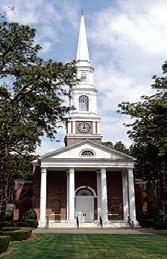
8:15am 9:30am 11:00am 8:15am 9:30am
2nd & 4th Wednesday of the month American Heritage Girls and Trail Life Troop 1898 meet at Heritage Hall October 2
6-7:30pm First Wednesday Fellowship 6pm New Member Orientation
October 5
9:00am - 2:30pm Women of the Chapel Fall Retreat -Carolyn Helms, Speaker 10-11am - Annual Blessing of the Animals
October 31
5-7pm - Fall Festival Trunk or Treat
Three Distinct Services
8:00am - Holy Eucharist 9:30am - Family Service with Children’s Sermon 11:00am - Traditional Worship




There’s no need to rush
Think push, pause, pull.’”
by lee PaCe
At the address of the golf swing, we talk about ball position, spine angle, grip pressure, takeaway and turn. At impact we talk about compression and clearing the hips and head position. Yet one element of the swing — under-appreciated and under-attended on the pages of golf magazines, YouTube instruction videos and Instagram golf pros — is the transition.
The top of the swing is the promised land of hitting good golf shots.
Getting too quick is kryptonite.
Taking your time is pure gold.
After all, if you’re going one direction and then want to reverse 180 degrees, you have to stop. What’s your hurry?
Renowned instructor Bob Toski tells his students to use the “Coca-Cola Swing,” employing a “pause that refreshes” at the top of the backswing.
“There should be no flash of speed at the top of your swing,” Toski says. “The club should be quiet and not bouncing. This gives you a chance to move the lower body down into the swing. You want to feel that you push the club back and pull it through.
Sean Foley, instructor over the years to noted golfers such as Tiger Woods and Justin Rose, counsels his pupils to be patient with the downswing. He uses the word “collect” in talking of the process of moving from backswing to downswing, particularly as it applies to the Englishman Rose.
“Too often, Justin gets a little tense at the top, and his transition back down to the ball is rushed,” Foley says. “Your arms should just fall from the top, rather than jerking the club down.”
Fred Couples, owner of the most liquid swing in golf and 1992 Masters champion, likes the word gather
“Couples talks about ‘buying time’ at the top of the backswing,” says golf instructor Jim Nelford, a contemporary of Couples’ on the PGA Tour of the 1980s and ’90s. “Never be in a hurry. Take your time on your backswing. Couples will gather at the top and just let the club drop.”
Pat McGowan, a PGA Tour regular from 1980 through the early 1990s, was struggling when the tour arrived in New Orleans for the USF&G Classic in late March 1989. He was miserable throughout a practice round on the difficult Jack Nicklausdesigned English Turn Golf Club, all the penal water and sand accentuated by brisk winds. His friend and playing companion Phil Blackmar convinced McGowan to make rehearsal swings when the tournament started by swinging back to perfect position and exaggerating a pause to five seconds.
“You’ll look like an idiot, but so what?” Blackmar said, plung-
















ing the gallows humor knife as only good golf buddies can do. “You’ll look bad shooting 78. You might as well try it.”
McGowan did as suggested, shot a 68 to open the tournament, followed with a 70 and a pair of 71s for a ninth-place finish, his best of the year. You might get that story today from McGowan if you get rushed at the top on the practice tee at Pine Needles Lodge and Golf Club, where McGowan is the lead instructor.
“Some people act like the ball’s moving, that you’ve got to hit it before it runs away,” McGowan says. “The ball’s not going anywhere. Finish your backswing first. That exaggerated pause at the top during the practice swing carries over to the full swing and slows you down.”
Andrew Rice teaches that very move from his outpost at the Westin Savannah Harbor Golf Resort. He calls it the “Power Pause Drill.” At first, he’ll have a pupil swing to the top and pause for a count of three, then hit the ball. After that exaggerated feel, he’ll ask them to pause for just one second. The idea is that the feeling will become engrained.
“One thing I see is that golfers don’t complete their backswing,” Rice says. “Another is that they go jumping out of the gate with rotation, trying to get some energy running down the shaft into the clubhead. It’s a short, incomplete backswing.
“With this drill, they make a full, complete backswing and store that energy. It’s like touching home plate.”
John Marino, the longtime head pro at Old Chatham Golf Club in Durham, spent a lot of time talking golf over the years with Dick Coop, the professor at the University of North Carolina who had a sideline consulting with professional and elite amateur golfers on the mental side of the game. Coop played golf himself and was a member at Old Chatham.
“Dick liked to say, ‘If your shaft was a perch, let the bird land on it before you start your downswing,’” Marino says. “A smooth transition will help create good balance and good sequencing. Everyone wants to be ‘that guy’ at his club with perfect tempo. That idea helps you get there.”
Cameron Young is the poster boy





Offenbach’s Les Contes d’Hoffman October 5th, 2024 1:00 PM Jessie Tesori’s Grounded October 19th, 2024 1:00 PM
Verdi’s Aida January 25th, 2025 12:30 PM
Beethoven’s Fidelo March 15th, 2025 1:00 PM


Strauss’s Salome May 17th, 2025 1:00 PM
Rossini’s Il Barbiere di Siviglia May 31st, 2025 1:00 PM







on today’s PGA Tour for the benefits of coming to a complete stop at the top of the swing and then exploding into a massive spark of speed through the ball (he was No. 7 on the driving distance meter in 2023 with 316 yards a pop). Young learned to play golf from his father, David, who was the head pro at Sleepy Hollow Country Club, just north of New York City. As a junior golfer, Cameron struggled to match his swing plane going back and then coming through.
“Cam’s worked hard on not having a lot of rerouting during the transition, so the clubhead comes down not too far from the direction where it went up,” his father says. “He wants to get the lower body working toward the target while he pins his arms, club and upper body back, which makes it look like he’s standing still. There’s no conscious effort to pause.”
And you can find a talented and social media-conscious golfer on Instagram and YouTube today named Ben Kruper, who bills himself as “The Pause King.” Kruper developed his distinctive pause in 2023 working on his game while playing mini-tour events and developing a digital venue presence.
“I had a super quick transition and wanted to do something kind of drastic,” he says. “It’s helped my game a ton. That quick transition would get me way behind, I’d get stuck, and I’d have to flip at the ball. Under pressure, it got so out of hand.”
In one YouTube video, Kruper wields his syrupy tempo to one pure strike after another as golf instructor Grant Horvat watches.
“My God, you can’t hit it any better,” Horvat enthuses. “Perfect dollar-bill divots, one after another. You know, you’re pretty good at golf.”
With that, it’s off to the practice tee with a bottle of Coke to set beside that bucket of balls. PS
Lee Pace has written about the Pinehurst experience for more than three decades from his home in Chapel Hill. Write him at leepace7@gmail.com and follow him on X @ LeePaceTweet.



















Regal in his red cap and Nehru tunic, he summons with a silver whistle, depended from a silver tassel around his neck, a taxi for Jacob, our first-born –mere minutes to make his train to Philadelphia, then another to New York, and the plane to Dubai, then Zambia. How can it be that you raise children for the world and they rush off to it, places and people you’ll never see. Is that your son, the doorman asks. When I am unable to answer, he tells me of his son, in Iraq, his fear of the telephone he can’t bear to answer.
All week, this man has held doors for me, hailed cabs, smiled as if he did not have such a son.
— Joseph Bathanti
Joseph Bathanti was North Carolina’s Poet Laureate from 2012-14. He’s one of the five authors inducted this month into the N.C. Carolina Literary Hall of Fame.
In the early 1930s, in a village not so very far away, masquerade balls were all the rage. Over time, the Carolina Hotel celebrated New Year’s Eve, St. Patrick’s Day and Valentine’s Day with dressup galas. Guests and cottagers were “invited” to attend by Leonard Tufts himself, and admission was by card only. Invitations for guests were procured at the Carolina office. Other balls, sponsored by the Sandhill Shrine Club, were held at the Pinehurst Country Club. Donald Ross was the chairman of the Ball Committee

and invited attendees by letter describing the club’s purpose, and enclosing a ticket and a stamped envelope. Tickets were $5, and proceeds supported the community’s “little sufferers.”
These events, however, were no match for the revelry of the employees’ masquerade balls. The annual “Frolic in the Spring” was attended not only by employees, but cottagers and guests as well. Held at the Carolina Hotel, the annual ball started with a parade from the dining room, down the great hall, and into the ballroom. According to the April 3, 1931, Pinehurst Outlook, “The annual employees’ masquerade brings out the best array of costumes seen during the entire season.”
— Audrey Moriarty

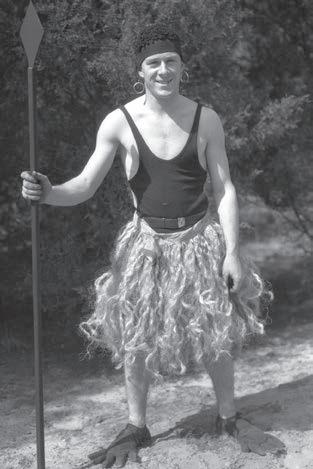
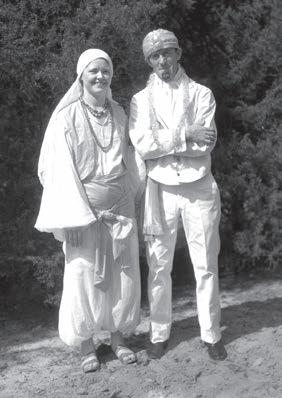
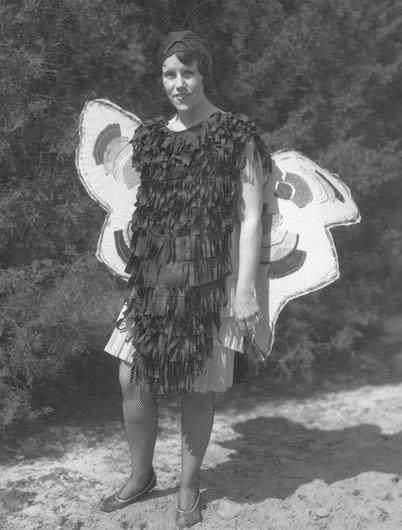






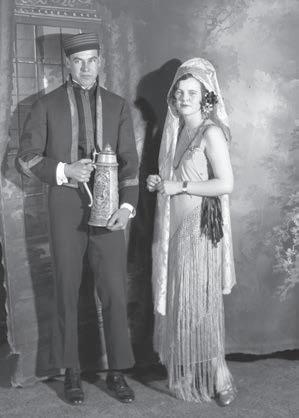


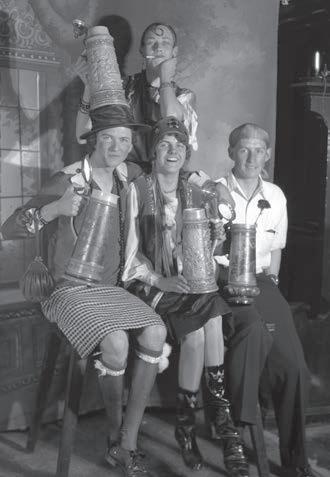
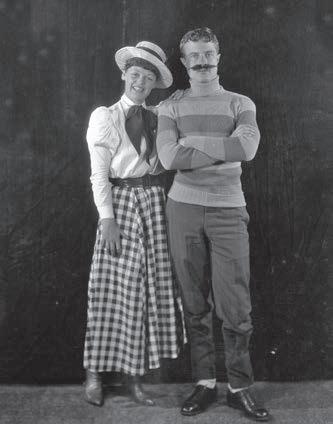


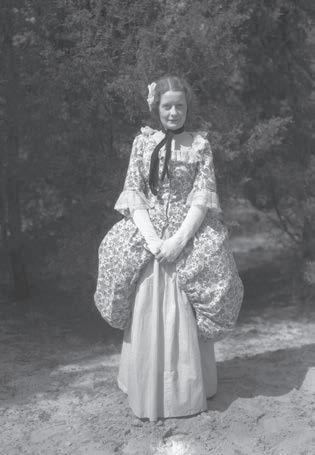



The new inductees to the North Carolina Literary Hall of Fame include two bestselling novelists, a famed author-educator, a world-renowned master of haiku and a former North Carolina poet laureate. Ron Rash, Kaye Gibbons, Anna Julia Cooper, Lenard Moore and Joseph Bathanti will join the pantheon of North Carolina’s most celebrated literary voices in the biannual induction on Sunday, Oct. 6, at 2 p.m., at the Weymouth Center for the Arts & Humanities. The festivities are free of charge and open to the public.
It has been 60 years since Anna Julia Cooper departed the world at the age of 105.
Consider for a moment the breadth of her life: Born into slavery in Raleigh in 1858, three years before Fort Sumter was fired upon, Cooper was the youngest child of Hannah Stanley, a woman enslaved by the man who was presumably Anna’s father. On Feb. 27, 1964, Cooper died in her sleep in her Washington, D.C., home, just 17 days after the Civil Rights Act passed in the United States House of Representatives, and a few months before Lyndon B. Johnson would sign it into law.
“It isn’t what we say about ourselves,” she told an interviewer on her 100th birthday, “it’s what our lives stand for.”
The life of Anna Julia Cooper — educator, essayist, poet, scholar, cultural critic and theorist — was the subject of a recent play, Tempestuous Elements, written by Kia Corthron and performed at the Arena Stage in D.C. “Yet for all her accomplishments,” said a review in the Washington Post, “Anna Julia Cooper remains a relatively obscure figure. Kia Corthron’s Tempestuous Elements . . . gives Cooper the Mount Rushmore treatment she so richly deserves.”
As another reviewer remarked, “My main question is, why didn’t I know about her until this play?”
In 1867 Cooper was among the first students admitted to St. Augustine’s Normal School and Collegiate Institute, an Episcopal school founded in Raleigh to educate those freed from slavery. Even there she bristled at excluding women from courses in theology and the classics. In 1877 she married George A.G. Cooper, a teacher at St. Augustine’s who was 14 years her senior. He would die two years later.
In 1881 Cooper enrolled at Oberlin College in Ohio, the first college in the U.S. to admit both Blacks and women. Even there Cooper had to fight, successfully, to gain admittance to the “gentlemen’s course” of study. She graduated with a Bachelor of Arts degree in 1884 and followed that with a Master of Science degree in mathematics in 1887. Shortly thereafter she was invited to join the faculty of what would become known as M Street High School, later Dunbar High School, in Washington, D.C. In 1892, Cooper authored A Voice from the South by a Black Woman of the South, a collection of essays credited as the first discourse on Black feminism.

At the beginning of one chapter, Cooper mentions a book titled Shall Women Learn the Alphabet, which proposes that such a thing should be prohibited by law. “Please remember this book was published at the beginning of the Nineteenth Century,” Cooper continued. “At the end of its first third, (in the year 1833) one solitary college in America decided to admit women within its sacred precincts, and organized what was called a ‘Ladies’ Course’ as well as the regular B.A. or Gentlemen’s course.
“It was felt to be an experiment — a rather dangerous experiment — and was adopted with fear and trembling by the good fathers, who looked as if they had been caught secretly mixing explosive compounds and were guiltily expecting every moment to see the foundations under them shaken and rent and their fair superstructure shattered into fragments.”
So, yes, this was a woman who could write.
In the wake of the international success of A Voice from the South, Cooper addressed the World’s Congress of Representative Women held in conjunction with the World’s Fair in Chicago in 1893. In 1900 she was on the executive committee of the first Pan-African Conference in London and was the only woman ever included in the American Negro Academy.
In 1902, Cooper became the principal of the M Street High School, and it is her five-year stint there, confronting the racial and gender inequities of the Jim Crow era, that serves as the basis for Tempestuous Elements.
Cooper insisted on a college prep, classical liberal arts curriculum. M Street sent graduates to Harvard, Yale, Brown and Oberlin. She invited W.E.B. Du Bois to address her students. It was her bristling refusal to dumb down the curriculum that led to her confrontation with a white-dominated board of education that was insisting on a “colored curriculum.”
According to Shirley Moody-Turner, the editor of The Portable Anna Julia Cooper, “The tactics used to discredit Cooper followed a recognizable pattern: public shaming, presumed incompetence, questioning her professional judgment and other innuendoes used to cast doubt on her fitness to lead.” This included rumors
Believing that the study in his home was in such a state of cyclonic disarray that meeting there would be an impossibility, or at least an embarrassment, Joseph Bathanti and I sat together in the humble space — roughly the size of a mini-storage shed — reserved for a professor of English at Appalachian State University.
He was on crutches, though this sounds worse than it was. His tendons, ligaments and joints were taking a breather from longdistance running. On the desk near his phone is an autographed copy of the album The Freewheelin’ Bob Dylan. It’s separated by a pile of books, a pair of scissors and whatnot from a copy of Howl. On the wall is a photograph of Roberto Clemente, a hero, beside a flier cordially inviting the public to follow the crowd to see and hear Sen. John F. Kennedy in October 1960.
The bookcases — there are exactly as many as the space will accommodate — are filled with volumes standing up, lying down, stacked and tilted, the top shelf crowned with baseballs, bobbleheads, photos of kids and more books. Joan Didion is near Gay Talese, who’s not far from Existentialism from Dostoevsky to Sartre, which is right above Becoming a Writer. The chair I occupy beside his desk is covered in garish Picasso-chic fabric. Against the wall behind it is an enormous playing card, the jack of hearts, which
of a liaison with John Love who, along with his sister, was taken in by Cooper after they were orphaned and continued living with her into adulthood.
Lastly, Cooper was accused of insubordination, of which she was profoundly guilty. She was dismissed from her position in 1906. “When Cooper arrived for the first day of school, the janitor barred her from entering the building,” writes Moody-Turner. “Police officers observed from across the street. They were ordered to arrest Cooper if they deemed she was creating a disturbance. With her students watching from the windows, Cooper — always a model of dignity and decorum — exited the school grounds.” Her curriculum, however, survived her.
After the M Street debacle, Cooper taught for four years in Missouri before returning to M Street to teach Latin. Following the death of the wife of a nephew (according to the Oberlin College alumni records), in 1915 Cooper adopted their five children: Anna, Regia, John, Marion and Andrew.
When the children were old enough to be enrolled in boarding schools, Cooper continued her academic pursuits, obtaining a degree from the Sorbonne in Paris at the age of 67, the fourth African American woman to receive a Ph.D. there. Following her retirement from teaching, she became the second president of Frelinghuysen University, an institution that educated Black adults while they continued to work.
Appropriately, Cooper may have written her own epitaph in that long-ago interview on the day she turned 100: “I don’t remember ever having taken anything just for myself.”

served as the cover of his book The High Heart.
Named North Carolina’s poet laureate in 2012, one of Bathanti’s go-to lines is, “Pittsburgh is my beloved hometown, but North Carolina is my beloved home state.” He has taught in our prisons and colleges, been to our hospitals, our shelters, our daycare centers and our soup kitchens. In actual fact, he is Pennsylvania’s gift to us.
Bathanti grew up in East Liberty, an Italian working-class neighborhood in Pittsburgh. “My dad was a steelworker, my mother a seamstress. They’re union people. They just work and work and work and work, so my sister and I can have this kind of life,” he says. He came to North Carolina as a VISTA volunteer, fresh out of grad school. “I didn’t know what I wanted to do but I had a ponderously long list of things I couldn’t stomach the thought of doing,” he says. The first thing he did was meet the love of his life, Joan Carey, also a VISTA volunteer, in the same ballroom that was a set piece in Gone with the Wind
“Jean Paul Sartre said somewhere that he pretended to be a writer until he became a writer,” says Bathanti. “I think that’s how we go about our lives. We pretend to be a father until we become a father. So, I just stayed with it. I continued to write badly, but I wrote less and less badly.”
He became a teacher at Central Piedmont Community College. “I made a living teaching,” he says. “I haven’t made a living on my writing at all, which most writers don’t. They have a straight job, as I like to say, so they can pay the rent, the gas.”
He fell into North Carolina’s community of writers. Kay Byer. Tony Abbott. Sam Ragan. Ron Bayes. Fred Chappell. Lee Smith.
It would be ironic if it weren’t so profoundly true that Lenard Moore has used the smallest of nets to capture, in stark and stunning detail, the chaos of our lives and his. A master of haiku and its many associated forms — tanka, senryu, renku and on and on — Moore was the first Southerner and first Black president of the Haiku Society of America, and the author of too many poems to count. He has been published in over 30 genres and translated into more than 20 languages.
With the pockets of his dapper sport coats stuffed with tiny notebooks, Moore doesn’t just write every day; he writes everywhere.
“I write all times of the day,” he says. “I write in the morning. I write at night. Walk through the woods, I write. Go to the beach, I write. In the mountains. It doesn’t matter. I go to basketball games, I always have a journal on me. I might have three.” In 1982, sitting in a Western Sizzlin’ all day, drinking a pitcher of sweet tea, he wrote 1,447 poems, and has stopped counting ever since.
Too many to mention them all. “They invited me to their tables. They talked to me. They read my stuff. Initially you think everything you write is incredibly brilliant like, wow, I just reinvented the wheel. I got more objective about my work, kind of blue collar, shoulder to the wheel, pigheaded, hang in there with it, which is sort of my method. There aren’t a lot of long runs, let’s put it that way. Three or four yards at a crack. But that’s OK,” says the former four-sport athlete at Pittsburgh Central Catholic High.
Having authored over 20 books across various genres, Bathanti has accumulated virtually every plaudit his adopted state has to offer — poet laureate, the North Carolina Award in Literature, the Order of the Long Leaf Pine and on and on. But the Literary Hall of Fame is on another level.
“It means everything,” he says. “I’m terribly grateful that a Yankee interloper, a son of Italian immigrants, has entered the pantheon. To me, it’s about my mom and dad. I’m taking Joe and Rose into the Hall of Fame with me, in a lot of ways. My whole family of immigrants, my cousins, my aunts, my uncles, all those people who work so hard, so selflessly. I show up here at age 23, a volunteer to work in the prison system who wants to be a writer but has never written a bloody thing except English papers. I would have never thought that something like that was possible. It was the very beginning of everything happening. It was kind of a magic portal I feel like I stepped through.”
Into our land. Into our literature.
Joseph Bathanti’s poem The Doorman at the Washington Hilton is on page 67.
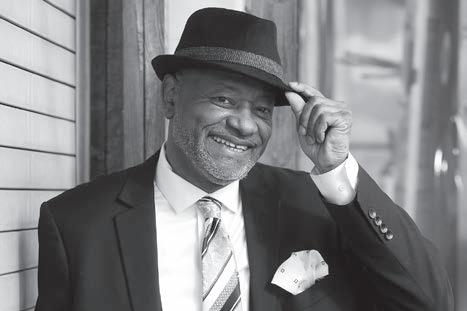
Twenty years ago Moore lost his only child, his daughter Maiisha, a student at East Carolina University, in a car accident two weeks after her 22nd birthday. Her self-portrait is on the wall of his bedroom. There are Chinese fortune cookies wrapped
in cellophane on the coffee table in his living room next to his daughter’s dictionary, its well-worn pages marked with as many yellow sticky notes as there are bees in a hive. On the shelf of an end table nearby is Maiisha’s Bible.
“That’s the worst thing that can happen to you. It’s kind of devastating. I went to the library about every evening for a year,” he says. “I wrote about her. I challenged myself. Writing is healing. If you go through tragedy, trauma or whatever, writing is there to help you.”
hot afternoon the squeak of my hands on my daughter’s coffin
It became one of Moore’s best-known haiku. “That poem kind of haunted me. At the burial I was the first one they called up to put a rose on the casket,” he says. “I put my hand on the coffin, maybe my hands were sweaty, I don’t know. I remember my hands slipped down the side and there was a loud squeak. It probably was about three days before I wrote it down. The poem just haunted me so I had to write it.”
Born in Jacksonville, North Carolina, in 1958, Moore grew up in rural Onslow County, the eldest child in a large family. He was priming tobacco by age 13, “climbing the tier poles; hanging the tobacco; in the field, on your feet; walking those long, long rows; sunup to past sundown.” He and his brothers chopped wood for his grandfather after school. “I think I got a knack for writing from listening to my grandfather tell stories. I’m sure that had something to do with it. I think if you write your truth and you document it and you try to have structure to it, you will be able to get an audience — if you tell the truth in that work. Emily Dickinson said, ‘Tell the truth but tell it slant.’”
In athletics he excelled on the track team, when he was known not as Lenard (pronounced Len-ARD) but as Dwane. He ran the mile relay for White Oak High School, and he and his sister, Angela, cleaned up at local dance competitions in the ’70s.
Kaye Gibbons was born in Nash County, North Carolina, in 1960, to Alice Dorothea Gardner and Charles Batts, a tobacco farmer. After their deaths, she lived with different relatives before settling in with her brother and his wife in Rocky Mount, where she graduated from high school in 1978. She attended North Carolina State University before transferring to UNC-Chapel Hill to study Southern Literature with Louis Rubin. In 1984, she married Michael Gibbons, a landscape architect.
That same year, at the age of 24, Gibbons wrote her first novel, Ellen Foster, published by Algonquin Books, the company Rubin founded in 1982. Praised as an extraordinary debut, Eudora Welty described the work as possessing “the honesty of thought and eye and feeling and word.” Walker Percy said, “Ellen
“Sports helped me,” he says. “I don’t give up.”
He won his first poetry prize in 1981 as a member of the 139th AG Postal Company stationed in Stuttgart, Germany. Back in the States, looking for that “audience,” he made sure he had “52 envelopes out at all times” to publications large and small.
Much of Moore’s work shares a kinship with the blues and jazz, his tight language giving form to genres that can expand and contract with the very lack of it. “I’ve performed a lot with jazz musicians all over the country, Canada, too. Hopefully, that’s a trademark of my work. Music,” he says. He writes about Dizzy Gillespie, Ray Charles, Nneena Freelon, John Coltrane and Nina Simone, but also of the clubs, as in the last two stanzas of “Girl Tap Dancing.”
She clicks, pats, taps Shoes shocking the floor, Arms swirl, whirl, Legs stamp, swing, Feet notes smoke, beat The floor, the floor.
She taps, clicks, pats, This sister firing the floor, Arms encompass endless circles, Legs slide, glide, Displace air, filling space, Black feather bobbing as she taps.
“This great community of writers, I’m humbled and honored to be a part of them,” says Moore of his induction into the Literary Hall of Fame. “It means a lot when home celebrates you. Home appreciates your work. Home gives you a nod to what you’re trying to do. Trying to document, write about the natural world, write about family, write about relationships, write about music. It makes me feel good that North Carolina appreciates that.”
Foster is a Southern Holden Caulfield, tougher perhaps, as funny . . . a breathtaking first novel.” In 1987, the novel won the Sue Kaufman Prize for first fiction from the American Academy and Institute of Arts and Letters, a Special Citation from the Ernest Hemingway Foundation, the Louis D. Rubin Writing Award, and other major awards. Now considered a classic, it is taught in high schools and universities, alongside works like The Adventures of Huckleberry Finn, Catcher in the Rye and To Kill a Mockingbird. The book has been widely translated and was produced for CBS television’s Hallmark Hall of Fame, starring Emily Harris and Jenna Malone.
Gibbons’ second novel, A Virtuous Woman, also received wide praise in the United States and abroad. The story, told in the voices of a dying wife and her widowed husband, was dubbed “a small masterpiece” by the San Francisco Chronicle.
Both Ellen Foster and A Virtuous Woman were chosen as Oprah Book Club selections in 1998 and led the New York Times bestseller list for many weeks.
In 1989 Gibbons received a grant from the National Endowment for the Arts to write a third novel, A Cure for Dreams, published by Algonquin in 1991. Writing about three generations of women, she used transcripts from the Federal Writers’ Project of the Great Depression, housed at Wilson Library in Chapel Hill. Gibbons said she discovered for the first time “the voice of ordinary men and women as a pure form of art and force of nature.” The Los Angeles Times Book Review described the novel as “full of unforgettable scenes and observations, characters drawn surely and sharply, and writing that is both lyrical and lightning keen.” It won the PEN Revson Award for the best work of fiction published by an American writer under 35 years of age, the Oklahoma Homecoming Award, the Sir Walter Raleigh Award for Fiction, and the Nelson Algren Heartland Award from the Chicago Tribune
When Charms for the Easy Life was published in 1993, it became an instant bestseller. The novel takes place between 1910 and 1945 in the home of three generations of highly intelligent and forthright eastern North Carolina women. It was followed by Sights Unseen, published in 1995, and a winner of the Critics Choice Award from the San Francisco Chronicle.
The following year, her sixth novel, On the Occasion of My Last Afternoon, was a story set during the Civil War. The Orlando Sentinel found it to be “a muscular narrative that humanizes all sides of that bloody conflict — North and South, Black and white, male and female.” Gibbons was described as “one of the most lyrical writers working today” by Entertainment Weekly.
In 1996 she became the youngest writer to receive the Chevalier de L’Ordre des Arts et des Lettres, recognizing her contribution to French literature. She spoke at the Pompidou Center in Paris and at the University of Rennes. In 1998, she received the North Carolina Award for Literature and, in 1999, North Carolina State University awarded her the honorary degree of Doctor of Humane Letters. She also received the Carolina Alumni’s Distinguished Young Alumni Award and was invited to become a member of the Fellowship of Southern Writers. She served as a judge for the Robert F. Kennedy Book Awards and wrote the introduction to the Modern Library Edition of Kate Chopin’s The Awakening and Other Stories Divining Women, published in 2004, is set during the influenza
Finding Ron Rash’s home is easy enough: Bear left at the tethered goat and keep climbing. Both a resident and chronicler of the high country, Rash is praised for his portrayals of the struggles and grit of the common and uncommon folk — from whom he is descended — of the Appalachians. A teacher, first in high school and then in a community college, Rash achieved his first criti-

epidemic of 1918. Gibbons also wrote The Other Side of Air that year, which was left unfinished after the death of her close friend, the writer Jeanne Braselton. The sequel to Ellen Foster — The Life All Around Me By Ellen Foster — was published in 2005. Gibbons is currently working on a memoir about the intersection of mental illness and creativity in her work, and has spoken and written about the need to remove the stigma from illnesses, like bipolar disorder, which she was diagnosed with in 1981.
— Adapted from the N.C. Writers’ Network
cal success as a poet. His debut collection, Eureka Mill, draws on the experience of his grandparents’ generation, migrating from the mountains to find work in the cotton mills and the cultural upheaval attending it.
Though Rash has become internationally known as a novelist, his work stayed home in the mountains. His bestselling 2008 novel Serena is the story of a newlywed Northern couple, George and Serena Pemberton, and the full-blooded ruthlessness of the title character as the couple cause multiple tragedies in their pursuit of
riches. The book was a finalist for the Pen/Faulkner Award.
A recipient of a Guggenheim Fellowship in 2017, Rash’s most recent novel, The Caretaker, was selected by The New York Times as one of its best books of 2024. “I set this novel on my grandparents’ farm between Blowing Rock and Boone because the happiest time of my life was spent on that farm,” says Rash. “The cemetery (appearing in the novel) is up there. Everything is the way it is in the book. I’ve always wanted to write about that place and finally did.”
Rash’s writing life, in a sense, began with a pulled hamstring — a poet in disguise with a soft tissue problem. Tall and fit, he was a more than serviceable track star running the 800 meters in high school and college. “I’m a terribly obsessive person,” he says. “I’ve never been interested in being well-rounded. I was training one day in the winter and it gave. Sometimes those things can heal but this one wouldn’t. I’d been dabbling with writing but then it was, what now?”
What now became poems and short stories. “I tried to write a couple of novels when I was in my 20s and another one when I was about 30,” he says. “They were terrible. I burned them. Did a service to the world. They were really bad but that was OK, I was learning. I didn’t try to write another novel until I was in my mid-40s. That was One Foot in Eden. I read it and thought, this is something I can have my name on and not be ashamed of.”
By his own admission, Rash’s nature tends to be solitary, and it shows in his workday. “I’m repetitive, structured, ritualistic. I eat breakfast, exercise for an hour, get a big thing of unsweetened tea. Get my pencils laid out. Everything kind of has to be in the right place. I like to write in my office (at Western Carolina University) because it’s so monastic.”
The session may last an hour or six. “When I was working on Serena I’d go 10 hours a day at times,” he says. “The part I love is editing. I hate first drafts. What I love is getting to the last stages. That’s when I’m just listening to sounds. The writers I love, when you read them you’re gliding. You don’t have those stumbles where the sentence is awkward or the word just seems to be wrong.”
In The Caretaker, Rash writes:
As he neared Middlefork, Blackburn saw to the left where, among broken slabs of stone, small blue flowers bloomed. If you came upon periwinkle in woods or a meadow, Wilkie said a graveyard likely had been there. It had always struck Blackburn how something fragile as a flowercouldhonorthedeadlongerthanstone.Longerthanmemorytoo, a lot longer.
If Rash showed early symptoms of a man who would lead an author’s life, those signs didn’t come solely in the form of an 800-meter race. “As a child my father had severe mental problems. He had to be institutionalized at times. I would go to my grandparents’ farm,” he says of the land occupied by The Caretaker. “It was peaceful. I could go out in the woods. In a way, I found solace in nature — no TV, no vehicle — and just wander. The land borders the Blue Ridge Parkway. I was like Huck Finn. I was just kind of daydreaming.”
Selection as a member of the North Carolina Literary Hall of Fame is particularly poignant for a writer whose work lives so

organically within the state. “So many of the writers who have inspired me are in there,” he says. “Fred Chappell, Lee Smith, Robert Morgan, they’re the generation that showed me the possibilities, and how to do it right. Each of them taught me something different. I think Fred gave me a sense of the possibilities of humor. Robert Morgan really showed me the possibilities of the details, the significant details of a place, knowing the landscape. Lee opened up the possibilities of writing stories. A wonderful sense of storytelling.”
His list of mentors, real and spiritual, unwinds as he talks: Thomas Wolfe; Robert Penn Warren; a bushel of European writers introduced to his universe by Chappell.
To the extent to which such honorifics are capable, there is one thing the Hall of Fame can do. “I am drawn to things that can be forgotten,” says Rash. These five inductees will not be among them. PS
Jim Moriarty is the Editor of PineStraw and a proud alumnus of Oberlin College. He can be reached at jjmpinestraw@gmail.com.

By Bill Case
Situated on Ritter Road in the Old Town section of Pinehurst is a decidedly quirky monument that could conceivably double as an immovable outdoor coffee table. A rectangular brick base, 18 by 21 inches wide and 18 inches in height, supports a circular sandstone slab 4 inches thick and 30 inches in diameter. Punched in the middle of the slab is a tiny hole.
Curiously, there are no inscriptions on the monument to indicate its significance. In 2001, the Pinehurst Civic Group placed a small engraved marker near the monument, a foot above ground level, for the purpose of enlightening puzzled passersby. The marker, titled SOLAR ECLIPSE MONUMENT MAY 28, 1900, reads:
On this spot astronomers and scientists from around the country came to observe and photograph the eclipse.
The punchmark in center is basis for all computations of location and distance measurements in this section of the country. It is also part of a gigantic scheme of world mapping that covers the entire Earth. Additional information at Tufts Archives in village.
To increase awareness of the mostly overlooked site, a tall historic landmark sign with identical verbiage was recently erected along Ritter Road by the village of Pinehurst.
So, what circumstances caused eminent men of science to select Pinehurst, then solely a winter resort town, as the ideal
spot to observe and study the solar eclipse? It would have been an inconvenient time for them to work here. By May 28, 1900, the fledgling resort and town would have already ceased operations for the summer. Who were these scientists, and what did they accomplish? Where did they eat and sleep?
While the Tufts Archives has in its collection numerous photographs pertaining to the Pinehurst eclipse expedition of 1900, it has little documentation concerning it. Like the resort, the Pinehurst Outlook, first printed in 1897, was in mothballs for that summer and would not resume operations until early November.
The January 5, 1900, edition of the paper did, however, herald the fact that “an excellent view of the total eclipse of the sun (on) May 28 . . . one of the great events of 1900, may be had at Pinehurst.”
Fortunately, other newspapers, including the Baltimore Sun, CharlotteDailyObserver,CharlotteNewsandtheHendersonGoldLeaf, did report on the Pinehurst eclipse expedition. A digital search of these ancient publications helped piece together the story.
The Naval Observatory in Washington, D.C., was the prime mover in organizing the Pinehurst expedition. Stimson J. Brown, the director of the observatory, petitioned Congress to authorize $5,000 to fund three eclipse stations. Two were in Georgia — one in Barnesville and the other in Griffin. The third was to be located in the vicinity of Southern Pines. The three expeditions were charged with performing identical missions, the thought being that if cloud cover hampered observations at one of the sites, hopefully the sky would be clear at the others. The May 28
total solar eclipse was the first in America since 1878, and with scientific techniques having improved markedly, there was much to be learned.
Brown tabbed the observatory’s professor of mathematics, Aaron N. Skinner, to find a suitable location to observe the eclipse in or near Southern Pines. Following Skinner’s two-day visit to the area in April 1900, he chose Pinehurst as the site. Though the town would be closing down on May 1, four weeks before the eclipse, resort owner, James W. Tufts (according to a report authored by Skinner) “courteously extended an invitation to the N.O. to locate an eclipse observatory on the property.”
Tufts assigned resort general manager C.D. Benbow the task of arranging necessary housing. Skinner reported that J.M. Robinson, owner of The Lenox rooming house (which later burned down and is now the site of a residence at 175 Cherokee Road), was induced to keep his operation open “for our entertainment.”
In fact, the emptiness of the town was viewed as a plus, according to the May 20 edition of the Charlotte Daily Observer (in an article reprinted from the Baltimore Sun), which said, “There are no curious persons to hinder the work . . . on the eventful morning.” Furthermore, the Pinehurst location seemed “to be all that is desired. There are no trees, woods, or buildings to obscure the view of the sun.” A marked contrast to the Ritter Road of today.
Professor Skinner and the observatory’s assistant astronomer, Theo King, arrived in Pinehurst on May 3 to begin preparations for the expedition on the “plot of ground about 800 feet southeast of the Carolina Hotel,” which was then in the final phase of construction. Because the station’s precise longitudinal and latitudinal position was critical, the first order of business was to lay out a
“meridian line” toward true north.
Naval Observatory records indicate that Skinner, in locating that line, placed a landmark exactly 1,100 feet north from the tiny hole in the monument slab. Does this landmark still exist? Using the compass on an iPhone and proceeding due north from the monument approximately 1,100 feet, I saw a circular metal object in the ground off Caddell Road. It was covered with design features that looked like astrological symbols. Could this be the long lost marker?
Uh, no. What I had discovered was a manhole cover — albeit an intricately designed one — made in India. The marker does, however, still exist. As luck would have it, Jill Gooding, the granddaughter of Pinehurst’s jack-of-all-trades (including surveyor) Rassie Wicker, was able to show me the location of the true north marker stone I had failed to find.
On May 8,, 1900, team members began trickling into Pinehurst to join Skinner and King. This was more than just a Naval Observatory operation. A contingent of six from Johns Hopkins University in Baltimore, led by 35-year-old physicist and professor Joseph S. Ames, would play a key role in the expedition. Ames would later ascend to the presidency of Johns Hopkins. He would also serve as a founding member and longtime chairman of the National Advisory Committee for Aeronautics, the predecessor of NASA. Professor R. W. Wood from the University of Wisconsin, Dr. F.L. Chase from Yale, and the Cincinnati Observatory’s E.I. Yowell rounded out the expedition. Ultimately 16 team members would have roles to play during the actual eclipse.
Other expeditions were arriving at various destinations along the eclipse’s 50-mile-wide path. The Smithsonian Astrological Observatory shipped several railroad cars of equipment from Washington, D.C., to Wadesboro, N.C. They were joined by teams from Princeton University, the University of Chicago, and the British Astronomical Association. Wadesboro was chosen because of the belief that the town’s high elevation made it less likely that clouds would impede visibility. Unlike Pinehurst, spectators flocked to Wadesboro in massive numbers (including those who arrived on a special excursion train from Charlotte) to view the eclipse and the feverish efforts of the Smithsonian expedition. The wave of people and publicity would cause Wadesboro to be generally remembered as the best place to have witnessed the 1900 eclipse.
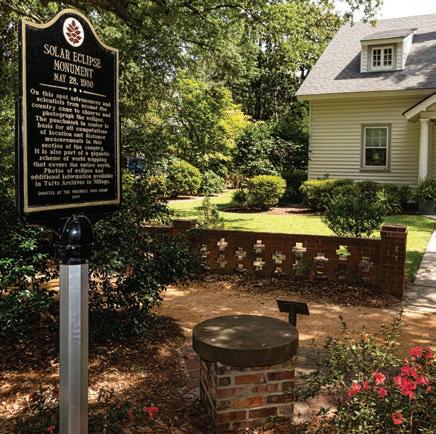
The Naval Observatory’s longtime historian, Geoffrey Chester, explained to me why eclipse expeditions proliferated at the turn of the century. Scientists were eager “to help refine the theory of the moon’s orbit in order to provide more precise data for navigational almanacs,” he says. “By observing the actual times of the ‘contacts’ of the moon’s climb with that of the sun, and comparing those with predicted values, those corrections could be incorporated into a refined theory.”
Moreover, the Naval Observatory’s historian says that “there were many measurements that could only be made during a total solar eclipse — in particular, high-resolution spectrograms of the sun’s chromosphere . . . and the solar


corona,” which enabled scientists to measure the elements present in these areas.
A May 26, 1900, article in the Charlotte Observer confirmed that the Naval Observatory’s expedition would indeed be studying the “the nature and constitution of the corona and chromosphere of the sun,” and elaborated on the reasons in layman’s terms: “(The atmosphere) of the sun consists of vapors or metals such as iron, calcium, and silver, together with many ordinary gases, such as hydrogen and oxygen. This atmosphere is called the chromosphere. Outside it, and seen on the Earth only at times of total eclipses, is a sort of irregular halo, with streamers going off in different directions, all of a brilliant white color against the blue of the sky. The cause of this corona is unknown . . . an attempt will be made to see how many different agencies are taking part in it, and to learn if its existence depends solely on the sun itself.”
On May 8, the various instruments required by the expedition were shipped from Washington to Pinehurst by the Seaboard Air


Line Railroad via freight car, and the team members diligently worked to assemble them. With the exception of last-minute adjustments, the staging of the Pinehurst site was completed several days later. A number of brick and cement piers, as well as wooden structures and tarps, were constructed to support and house the equipment. Among the instruments was a telescope mounted on two axes of motion parallel to the Earth’s axis, transits, and several types of spectrographs designed to assist the scientists in their quest to analyze the corona and chromosphere by splitting their emitted light into its component parts. A darkroom and 40-foot tower housed the camera equipment that would photograph the various phases of the eclipse. From a distance, the site would have given the impression of an outdoor produce market next to an oil well.
Once everything was in place, Skinner supervised regular practice sessions. In his report he says that in order to familiarize the operators with their instruments, “regular drills were executed several times a day for three or four days preceding the eclipse.”
Eclipses have multiple phases. The first begins when the moon’s shadow initially touches the sun’s edge. It lasts 70 to 80 minutes. The second phase happens when the sun is nearly covered by the moon just before totality. Its conclusion is marked by a single flash of light, likened to that of a diamond ring, appearing at the edge of the moon, as well as “shadow bands” — rapidly moving bands of light that can be seen reflected on buildings. The third phase, the eclipse’s totality, lasts no more than several minutes.
In drilling his team, Skinner was particularly concerned that its members be on the mark when the moment of the second contact arrived. Much of the expedition’s study of the corona and chromosphere was to commence at that instant. Thus, the practice sessions involved the calling out of five minutes before the anticipated flash, then one minute, then 10 seconds, followed by “Go!”
Fearing an overcast sky or inclement weather would ruin everything, team members anxiously awaited the morning of May 28. Professor Ames provided an account of that day for the print media. When that morning dawned, Ames wrote, “Nearly everyone in Pinehurst was up gazing anxiously at the sky. As the light grew stronger and it became evident that the day would be fair, joy prevailed and shouts could be heard.”
While attendance for the eclipse at Pinehurst was paltry compared to Wadesboro, there was an influx of camp followers in town as the event approached. Ames reported that in the final two days, “all the meals at the astronomers’ boarding house (the Lenox) were served in two or three relays.” The actual working team of the expedition was “given the right of way, and had the privilege, if it may be called that, of having breakfast at 5 a.m.”


After that, according to Ames, “came the preparations of the buildings for action. The curtains were raised from the sides of the observatory, rafters were taken out, and hastily constructed roofs were taken down. In a short time, all the instruments were exposed to the sky, where the sun was slowly rising.”
Final rehearsals followed as the team members synchronized their watches. “We all knew that the instant of second contact had been calculated at 46 minutes, 16 3/10 seconds past 8 o’clock.” Ames confided, “There is enough uncertainty as to the moon’s true position at any time to make it possible there might be an error of a second or two in this predicted time.” The excitement within the team “was more intense than one would have expected. No one was willing to acknowledge this until afterwards.”
When the moment of first contact was announced, tensions were forgotten as the team sprang into action. They knew that the big moment of the “second contact” would be occurring in an hour and 10 minutes. “Everyone had his piece of smoked metal or colored glass,” said Ames, “and was intently watching the wasting away of the sun.”
Ames was fascinated by the spectacle unfolding before him. In conveying its grandeur, he wrote, “No wonder the poets of ancient civilization could picture the conflicts of huge beasts, one consuming the other in this great spectacle of nature.”
One researcher who was especially interested in examining shadow bands readied his stroboscope and spread a large linen sheet perpendicular to the sun’s rays, but the results of that particular experiment proved disappointing. Ames reported that “the shadow bands were conspicuous by their feebleness.”
At 8:46 and 6 3/10 seconds the team “heard the cry ‘Attention!’” meaning there was less than 10 seconds to go before the second contact. “All the photographic slides were withdrawn. Not a sound was heard even from the surrounding crowd,” wrote Ames.
Announcement of the command to “Go!” was assigned to Johns Hopkins team member Dr. W.B. Huff. He was to shout it immediately upon observing the flash signaling the start of the second contact. To perceive it, Huff employed a binocular, one barrel of which was fitted with a small diffraction grating.
Ames vividly describes the flurry of activity when Huff gave the command. “The lenses were uncapped, shutters were opened, and as the monotonous calling of the seconds proceeded one could dimly hear the sounds of changing plates and sliding camera boxes.” The predominant thing in the observers’ consciousness “was the rapidity of the flight of seconds and the absolute need of never allowing one’s mind to leave the work in hand even for an instant.”
However, there was a glitch in the timing of the command.

“Unfortunately the small diffraction grating attached to the binocular failed to render viable the flash at the second contact and delayed the starting signal by 25 or 30 seconds,” said Skinner’s report. “Consequently valuable time was lost.”
Once the action started time passed rapidly until Huff shouted, “Done!” The eclipse was over as the crescent of the sun gradually peeked out from behind the moon. After the taking of a few final spectrum photos, the dismounting and packing of the equipment commenced. “As fast as the covers were screwed on the boxes were carried to a freight car standing nearby,” wrote the professor, “and in an almost incredibly short period the appearance of the whole place had changed entirely.” By 10 o’clock, all evidence of the expedition was gone, except, of course, for the monument.
Notwithstanding the delay in calling out the flash, the expedition provided substantial data and excellent photographs of the corona and total eclipse. Ames declared it a success and credited “the energy and industry of Professor Skinner, who has done everything in his power to carry out the plans formed early in the year by Professor Brown.”
The expedition was largely forgotten in Moore County until an article in the Nov. 28, 1931, edition of the Pinehurst Outlook when the paper’s editor, Bion Butler, described efforts to determine the precise longitude and latitude of what is now the Moore County Airport. It was the legendary Rassie Wicker who arrived at a simple solution: Use as a starting point the solar eclipse monument, known to have a north longitude of 35 degrees, 11 minutes, and 38.23 seconds and a west latitude of 79 degrees, 28 minutes, and 12 seconds, then work from there. And that’s what happened.
Thus, the humble “coffee table,” left behind by the Naval Observatory nearly 125 years ago, rather uniquely, served a practical purpose — as well as commemorating a historic astronomical event. Doesn’t that make it the best type of monument? PS Pinehurst resident Bill Case is PineStraw’s history man. He can be reached at Bill.Case@thompsonhine.com.

By DeBorah salomon • Photogra Phs By John gessner

Imagine a residence resembling an Impressionist watercolor of all things spring. Imagine that it never fades or droops or goes to seed from summer’s heat. Turquoise predominates, cool as a rushing stream, channeling Monet. Birds flutter, some painted, some carved, some blown glass perched on a delicate glass birdbath. Yellow walls warm as May sun illuminates a living room housing two grandfather clocks, skirted end tables, leafy wallpaper, a thickly upholstered extralong, 60-year-old sofa and, for contrast, a porcelain urn tall enough to house the ashes of a dynasty of pharaohs.
Mallory Hickey, dressed in lime linen, calls the result “my happy house.” Her friends call it “Mallory’s Gallery.”
The house, an elegant yet informal English country manor clad in white stucco with narrow shutters, was built in 1923 by the Tufts organization for a Mrs. Butterfield who, according to correspondence on file in the Tufts Archives at the Given Memorial Library, expressed multiple petty grievances. Subsequently, Richard Tufts is said to have lived there. Without complaint.
In an era when country homes needed names, this mild-mannered specimen was called Blackjack Cottage, not for connec-

tions to gambling or even rakish Black Jack Bouvier, Jacqueline Kennedy’s hard-drinking, high-rolling father. Rather, the lot was overgrown with blackjack oak trees named for its bark divided into ebony plaques.
Could this be why Hickey painted the foyer opening onto an otherwise pastel interior . . . black? No. “Black is neutral,” the chatelaine says. It’s also a contrast. The antique Irish rocking horse leaning against the staircase suggests that surprises await.
For 30 years Hickey has been leaving her imprint on this manor on the edge of Pinehurst village, where construction dug up a crumbling tombstone engraved “John O. Fisher 1889,” its provenance a mystery.
In the early 1990s Hickey and her late husband, John, Michigan residents, contemplated early retirement, she from an upper-echelon job with American Airlines, he from marketing. They took two weeks off to scope out Hilton Head, Savannah,
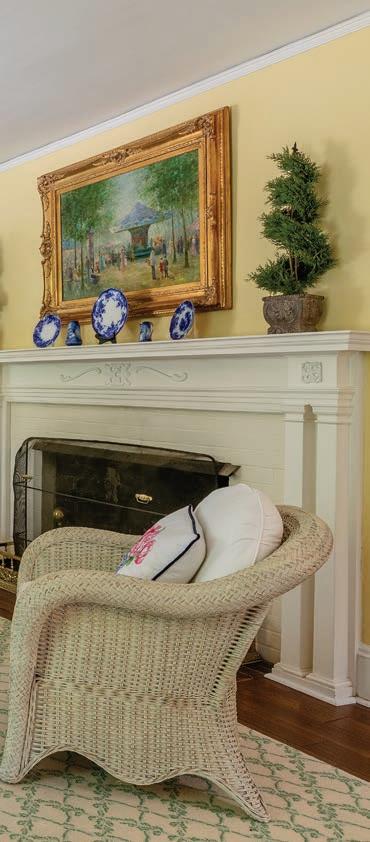




et al. Friends had moved to Pinehurst. It made sense to stop on the way home one lovely October.
“We checked into the inn. I thought, what a cosmopolitan place,” Hickey recalls. Just for fun, they looked at houses. In Blackjack Cottage she saw beyond the shag carpet and flocked wallpaper. They rented, then purchased, the property, which she would spend decades transforming.
“I’ve done the kitchen twice,” she says.
First, they needed to replace the upstairs master suite with something more substantial and comfortable, preferably on the ground floor. The new wing of mammoth proportions has a vaulted, timbered ceiling rising 20 feet, dwarfing two queen-sized beds. Its seating area with sofa, tables, fireplace and bay window overlooks a terrace. Here, summery pastels give way to richer hues, forest green and deep coral, a contrast continued in the TV/library/den, just off the living room, where dog art rules.
On the bay windowsill, Gracie, a 14-year-old retriever mix, stretches out in her bed. “We found her in a dumpster in the Dominican Republic, when she was a puppy,’’ Hickey says. Also in residence, three cats, the eldest pushing 20.
Each room contains something notable. In the dining room one of three corner cupboards displays Hickey’s collection of vibrant Majolica pottery. The dining table (with no extensions) seats six — eight in a pinch — since this hostess prefers intimate, informal dinners seasoned with lively conversation. Its skirted chairs are upholstered in white. Not to worry, she explains, ketchup wipes off.


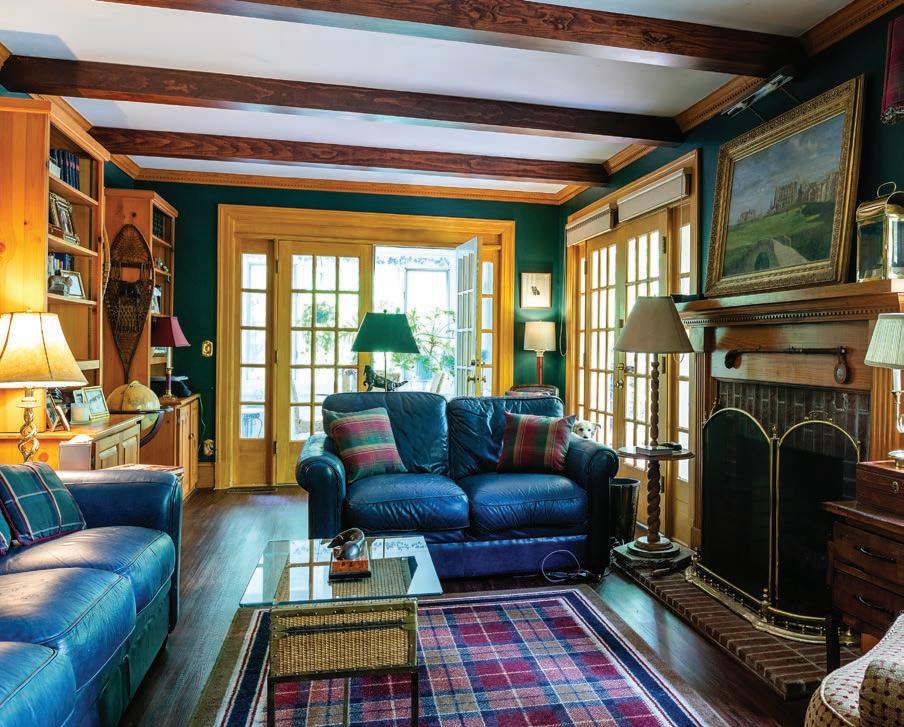
About that twice redone kitchen: If most Pinehurst manor house kitchens are sequined ball gowns, this one is a finely tailored suit in sand, beige and off-white with a beadboard ceiling and furniture-finish island, softened by an eyebrow window over the farm sink. In here, the cry of the Wolf range goes unheeded. Hickey did not submit to Sub-Zero, either. In a home a shade under 5,000 square feet, the proportions of the modest but elegant kitchen meet her needs. “When guests congregate here I chase them out,” she says pleasantly.
Upstairs belongs to family mementos, beginning with photos of Hickey’s mother and grandmother in the stairwell, continuing with a framed christening dress, a bedroom set, quilts, art and snapshot collages. “My grandfather came over from Russia,” she says, drawing attention to a photo. “He jumped
ship in New York.” She saved his bed, along with a figurine of a lady that was broken in a fall and mended by a child with chewing gum. A narrow indoor balcony overlooks the sunroom, a veritable bower adjoining the living room. Sitting there is like being outdoors minus inclement weather.
The gardens are lush and densely shrubbed, a goldfish pond is covered with wire to thwart fishing birds.
Mallory’s Gallery, indeed, enhanced by grand spaces and small treasures — stained glass window panels, a framed Hermes scarf and, on the swinging doors, raised metal finger plates from New Zealand.
“I live in a bubble — secure, far from the madding crowd,” Hickey says. Then admits the obvious: “I love Monet water lilies.” PS



Whodunnit again? Bestselling fiction trio Beatriz Williams, Lauren Willig and Karen White, known for their 2022 New York Times-bestselling novel, The Lost Summers of Newport, are back to thrill readers with another page-turning mystery. Step inside the walls of the historic Castle Kinloch, where a literary superstar has been found dead. Agatha Christie meets Knives Out in their forthcoming novel, The Author’s Guide to Murder.
Join us to hear our three writers discuss their new novel. Tickets include heavy hors d’oeuvres and two drinks (catered by Grandover).
Sunday, November 10, 2024
2 — 4 p.m.
Grandover Resort & Spa, 1000 Club Road, Greensboro, NC 27407
Tickets: ticketmetriad.com Supported


By a shley Walshe
October speaks through the beaks of 1,000 crows.
Can you feel them gathering? Murders of 20, 40, 60 strong, each bird like a sibyl gone mad.
“The sun is sinking, sinking, sinking,” they shriek, raspy voices harsh and urgent.
You know it’s true. The days are much too dark, too soon. And yet, right now, the sky is a cloudless blue; the maple is thick with yellow leaves; the light has washed everything golden.
Don’t let the raucous birds rip you from the moment: The warmth of sunlight on your face; the scent of wet earth; the swirl of amber leaves somersaulting through endless azure.
The crows kick it up a notch, throw back their ink-black heads, blurt their ghastly premonitions until their babble turns to laughter.
Dark and maniacal, their howling conjures a mighty wind. Do not be frightened by the glossy-winged seers. Let them rally in the shadows while the days are still honeyed. Let them pull you more fully into the luminous now.
Cock your head sideways as the crows do. Can’t you see? It’s all here — the freshness of the season; the bitter whiffs of sweet decay.
Notice that the crunch of dead leaves somehow enlivens you. “Yes, the sun is sinking,” you want to call back. “But . . . the air is alive! The leaves are turning cartwheels!”
A wild laugh rises from deep within you. The light is fading. The crows are cackling. As autumn picks at her own golden thread, even the dead leaves seem to snicker.
Nothing says wholesome autumn fun like a pumpkin patch. Adorable. But if you’re looking for a pick-your-own adventure with an edge, venture to an apple orchard.
Spend a quiet hour among the trees. Study the gnarled branches. Listen for the thud of ripe fruit knocking against the sleepy earth. Dance with the shadows.

About 75 percent of our state’s apple crop is grown south of Asheville in Henderson County. Should you head west to peep and marvel at the turning leaves, consider stopping by an orchard — or farm stand — for the freshest of the fresh.
At the very least, snag a gallon of cider to-go.


I remember it as October days are always remembered, cloudless, maple-flavored, the air gold and so clean it quivers.
— Leif Enger, Peace Like a River
True leaf peepers will tell you that the best time to hit the Great Smoky Mountains or Blue Ridge Parkway for peak fall colors is the second week of October. Go a week early and be underwhelmed; a week late and you’ll miss it.
Whether or not you take the drive, the color show will surely find you — if not through leaves then through flowers. Kaleidoscopic chrysanthemums. Luminous marigolds. Tender snapdragons. Drifts of brilliant pansies.
And just watch how autumn light transforms every gorgeous hue.


Whether you’re looking for an intimate date night or a place to feed the whole family, take a peek at some of the best dishes and ambience that our neighborhood has to offer.





Beefeaters is a cherished Southern Pines landmark that has stood the test of time. For over 25 years, this beloved establishment has been serving up mouthwatering steaks, burgers, seafood, salads and nightly specials that keep diners coming back for more. Owner Will Faircloth is deeply committed to food quality, never compromising it for cost. He upholds rigorous standards for every cut of beef and ensures that the cooking process delivers a consistently exceptional steakhouse experience. Come discover why Beefeaters has been voted Best Steak for 10 Years in a row!




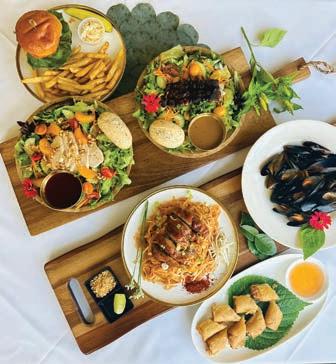


Table on the Green offers culinary excellence within the tranquil beauty of a golf course setting. As Pinehurst’s premier dining destination, this restaurant beautifully marries classic American cuisine with the exotic flavors of Thailand, creating a unique and memorable dining experience. The warm and inviting ambiance of Table on the Green

reflects their commitment to making every guest feel at home. The diverse menu includes many vegetarian and vegan-friendly options. Their catering services extend the same quality and care to your special events. Discover a haven where elegance meets flavor, and where every meal is a celebration of culinary artistry.


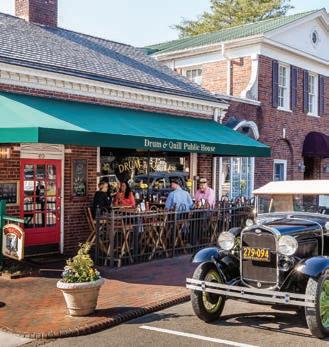


Hidden among the tall pines of Pinehurst is a storied authentic American tavern, Drum & Quill. Voted Most Authentic Pub in the Best of the Pines contest for four years and built on the old Irish tradition of a Public House, a place to gather or a cozy place to eat, drink and make new friends, Drum & Quill offers a covered patio to gather outdoors rain or shine.

Drum & Quill is celebrating the 10th anniversary by introducing the pub’s first ever executive chef, Kathleen Wiggs. With a new chef at the helm, Drum & Quill is stepping out as much more than just a pub. Chef Kat specializes in Southern fusion and emphasizes locally sourced ingredients from The Bakehouse, The Pinehurst Olive Oil Company and Lazy Fox Lavender Farm.
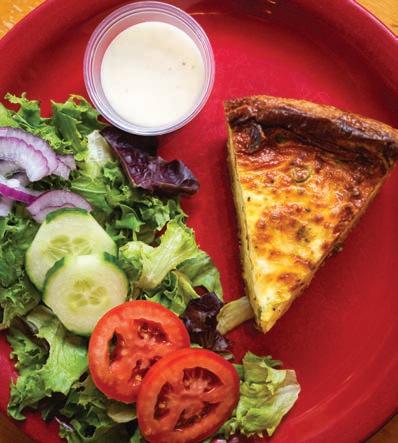





Midland Bistro in Southern Pines embodies quaint charm and warm hospitality. Nestled off Midland Road, this beloved local spot takes pride in supporting its community through locally sourced ingredients. Emphasizing seasonal produce, Midland Bistro offers a delightful menu
for breakfast and lunch. Its cozy atmosphere and friendly service makes it the perfect destination for a comforting and satisfying meal. Whether you’re a local or just passing through, Midland Bistro is a must-visit for a taste of genuine Southern Pines.




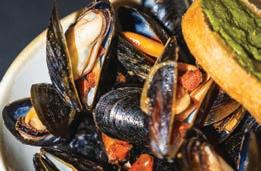

Few venues at Pinehurst Resort better infuse the stylings of our vintage past with the modern comfort and casual elegance that we are today than our newest outlet, the Carolina Vista Lounge. Completely renovated, Carolina Vista Lounge is an expanded cocktail bar with a contemporary menu unlike any other at Pinehurst, offering diners a stylish and satisfying respite befitting its setting in the historic Carolina Hotel. And yes… the Mile-High Key Lime Pie is served here. Treat yourself to a culinary experience and enjoy dining out again at the Carolina Vista Lounge.




At BIBIBOP, we prioritize serving high-quality, unprocessed food, believing that a nutritious meal can kickstart your journey to health. Our commitment to affordability ensures you don’t have to pay more for wholesome options. As a family-driven business, we focus on daily improvement and supporting everyone’s holistic health journey. Our menu is rich in South

Korean flavors, offering savory bowls that are gluten and MSG-free, making them perfect for family meals. With a focus on traditional Asian ingredients that combat health issues, explore our diverse bases, toppings, proteins, and sauces, all while enjoying peace of mind with our certified gluten-free offerings. See you at the new Southern Pines Location!





The Buggy Factory by Southern Pines Brewing Company, located in the historic Tyson & Jones building, is Carthage’s newest restaurant, bar and brewery. Known for Detroit-style pizza, frosty pints and handcrafted cocktails, the menu is curated by Executive Chef Emily Walden Harris, blending her Korean heritage into dishes like Korean Fried Chicken Wings

and K-Town Pizza. Enjoy live music on weekends, bluegrass during Sunday brunch and weekday lunch featuring housemade focaccia sandwiches. Downstairs, Tyson & Jones speakeasy offers high-end cocktails in a candlelit setting, perfect for private events. Rooted in the community, The Buggy Factory fosters connection and gatherings in Moore County.





At Chapman’s Food and Spirits, you’ll find delicious chef-driven, American fare in a comfortable, casual atmosphere. Enjoy unique spins on
on cocktails out on the patios in downtown Southern Pines. The kitchen produces a variety of specials along with their popular classics, such as the Ultimate Burger or their wicked good Crawfish Fries.





In love with food and each other, Mason’s Restaurant & Grocery began over Alison and Brian’s Hainley’s first brunch date as they brainstormed the concept of a “local brunch hang” with delicious, seasonal fare. Nearly 8 years later, Mason’s was founded and

opened its doors in January 2020. The contemporary restaurant in Downtown Aberdeen offers scratch-made biscuits and craft cocktails among their brunch options, and features a market with local and regional specialty products.



Thai Orchid holds the distinction of being Moore County’s first authentic Thai restaurant. Started by three sisters who enjoy making food and creating good memories. Since 1993 this family owned and operated restaurant has featured authentic Thai dishes made from the freshest ingredients. With a large menu that includes favorites like

Pad Thai and Drunken Noodles, as well as chef‘s specials like Choo Chee Fish, there is something everyone will love. Voted by locals to be the Best Thai Restaurant in Best of the Pines, Thai Orchid continues to be a gem in Aberdeen. Come by and try one of their delicious dishes and see why they are the best!
1404 NORTH SANDHILLS BLVD. | ABERDEEN NC 28315
910-944-9299 OR 910-691-2999



At Busaba, we’re redefining the dining experience by fusing our extensive industry expertise with a novel approach to food and ambiance. With over a decade of experience across various culinary landscapes, we’ve perfected our craft and gathered a collection of treasured recipes, including the highly praised beef

stew from my mother-in-law. Busaba is designed as a welcoming haven where you can enjoy exquisite, flavorful meals without the stiffness of fine dining. Whether you’re in the mood for a delectable meal, a cozy spot to work remotely, or a relaxed setting to hang out with friends, Busaba caters to modern tastes and needs with a laid-back atmosphere.
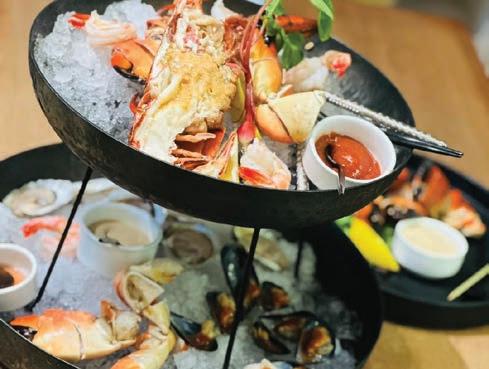





Family owned, Elliotts on Linden, showcases expertly crafted dishes made with regional and seasonal ingredients. Being ingrained in the community and utilizing our North Carolina produce is what makes Elliotts - Elliotts!
With a seasonal menu and a variety of meat, fish, and vegetarian options you’ll always

have a reason to dine. Enjoy a craft cocktail from our bar or pair a bottle of hand selected wine with your meal.
Elliotts on Linden is the dining experience for all occasions, anniversary, birthday, celebration, or - just because! A great meal with great friends nourishes the soul and community.





Husband and wife Jayarani and Ekambaram Elamaran opened Jaya’s with their daughter, Ria, in 2015 and have lived in Moore County for over 30 years. Having grown up up in Chennai, Tamil Nadu and Delhi, Jayarani and Elamaran felt it was important to follow Southern Indian traditions and stay true to their culture with their delicious, homestyle Indian dishes. The family business has won Best Indian Restaurant in Best of the Pines for the last four years.

Their most popular dishes are Butter Chicken and Chicken Tikka Masala, but Maran’s favorite dish is their Chicken 65 appetizer. With vegan, vegetarian and glutenfree options, Jaya’s provides delicious food for all dietary needs. You can often find their food truck at various events in Moore County, such First Friday, and they offer catering as well. You can always find something uniquely delicious at Jaya’s.


It’s never too early to start planning for the holidays. Make this season unforgettable with Wilders! Whether you’re looking to treat family and friends to premium gift bundles or surprise them with a subscription box, we’ve got the perfect gifts to share the finest locally raised Wagyu beef and Berkshire pork from Eastern North Carolina. Plus, with nationwide shipping, you can send the exceptional taste of Wilders to your loved ones wherever they are!
Order online today and make this year’s holiday gifting extraordinary!
For more details scan the QR code or visit our website at www.wilders.com/pages/happy-holidays.
WWW.WILDERS.COM | 919.551.8102


Although conscientious effort is made to provide accurate and up-to-date information, all events are subject to change and errors can occur! Please call to verify times, costs, status and location before planning or attending any events.
Tuesday, October 1
BRAIN FITNESS. 10 - 11 a.m. Adults 18 and older are invited to enjoy short relaxation and brain enhancement exercises, ending with a mindfulness practice. Eve Gaskell will be the instructor. Free of charge. Douglass Community Center, 1185 W. Pennsylvania Ave., Southern Pines. Info: (910) 692-7376.
BOOK EVENT. 6:30 - 7:30 p.m. The Country Bookshop and the First Bank Book Club present New York Times bestselling author Tui Sutherland and the release of Wings of Fire Limited Edition. Owens Auditorium, 3395 Airport Road, Pinehurst. Info: www.ticketmesandhills.com.
Thursday, October 3
TAG SALE AND RAFFLE. 2 - 5 p.m. Shop the White Elephant Tag Sale and Raffle for gently used furniture, art, household items, jewelry, toys, sports equipment, home baked goods and more. There will also be raffle prizes and a silent auction. Sneak Peek Tag Sale is Oct. 3 from 2 - 5 p.m. The tag sale will be Oct. 4 from 11 a.m. - 5 p.m. and Oct. 5 from 8 - 11 a.m. Raffle ticket purchase needed for admission to the Sneak Peek Sale. No entry fee Friday or Saturday. Proceeds benefit Sacred Heart Church Ministries and Moore County charitable organizations. Founders Hall, next to Sacred Heart Church, N.C. 211 and Dundee Road, Pinehurst. Info (910) 295-0704.
SUPPORT GROUP. 5:30 - 7:30 p.m. The Sandhills Chronic Kidney Disease Support Group meets the first Thursday of each month at Clara McLean House, Shadowlawn Room, 20 FirstVillage Drive, Pinehurst. Info: angela@sandhillsckd.com or kathy@sandhillsckd.com.
BOOK EVENT. 6 - 7 p.m. The Country Bookshop welcomes Marybeth Whalen and T.I. Lowe to chat about their latest books. The Country Bookshop, 140 N.W. Broad St., Southern Pines. Info: www. ticketmesandhills.com.
Friday, October 4
LUNCH BUNCH. 11:30 a.m. Adults 55 and older are invited to dine on different cuisines each month as we visit restaurants in the area. Carpool with friends or meet at the restaurant. Dining locations will be chosen the week before. Info: (910) 692-7376.
FIRST FRIDAY. 5 p.m. Come enjoy music from Ashes & Arrows at First Friday. Sunrise Theater, 250 N.W. Broad St., Southern Pines. Info: (910) 692-3611 or www.sunrisetheater.com.
COMEDY SERIES. 7 p.m. Enjoy some laughs
from Mike Goodwin on his “Big Dad Energy” tour. BPAC, 3395 Airport Road, Pinehurst. Info: www. ticketmesandhills.com.
QUINTET. 7 - 9 p.m. Live from the Great Room features music from Akropolis Reed Quintet. Weymouth Center, 555 E. Connecticut Ave., Southern Pines. Info: www.weymouthcenter.org.
Saturday, October 5
CRAFT DAYS. Children and their families can come by the library for Drop-in Craft Days and work on crafts and coloring at their own pace. Southern Pines Public Library, 170 W. Connecticut Ave., Southern Pines. Info: (910) 692-8235 or www. sppl.net.
AUTUMNFEST. 9 a.m. - 4 p.m. Enjoy a day full of arts and crafts, live entertainment, great food, kids’ rides, a fun run/walk, a 5K road race and much more. Downtown Park, 145 S.E. Broad St., Southern Pines. Info: www.southernpines.net.
WOMEN’S RETREAT. 9:30 a.m. - 2:30 p.m. Join us as we welcome Rev. Carolyn Dalton Helms as the guest speaker for the Women of the Chapel fall retreat with a talk on “Fear, A Four Letter Word.” The Village Chapel, 10 Azalea Road, Pinehurst. Info: www.ticketmesandhills.com.
MUSICAL STORY. 10 - 11 a.m. Pepito and The Trash Cans is a family friendly musical story. Free event, registration appreciated. Weymouth Center, 555 E. Connecticut Ave., Southern Pines. Info: www. weymouthcenter.org.
KIDS’ SATURDAY. 10 a.m. - 12 p.m. Families are invited to a monthly themed craft event to socialize and get creative. Geared toward ages 3 - 10. Given Memorial Library, 150 Cherokee Road, Pinehurst. Info: (910) 295-3642 or www.vopnc.org.
PUMPKIN PATCH TRAIL. 10 a.m. - 5 p.m. The Potters’ Pumpkin Patch Trail is a self-guided tour of five pottery galleries each offering unique fallthemed ceramic items throughout October with special event activities on each Saturday of the month. Tour starts at 247 W. Main St., Seagrove. Info: www.potterspumpkinpatch.com.
KILN OPENING. 10 a.m. - 5 p.m. This yearly event celebrates pottery and family. There will be new work fresh from the kiln, demonstrations and refreshments. From The Ground Up pottery, 172 Crestwood Road, Robbins. Info: www.fromthegrounduppots.com/new-events/.
MET OPERA. 1 p.m. The Metropolitan Opera opens its 18th season with Offenbach’s Les Contes d’Hoffmann Sunrise Theater, 250 N.W. Broad St., Southern Pines. Info: (910) 692-3611 or www. sunrisetheater.com.
SHAG SOCIETY DANCE. 7 - 10 p.m. The Moore Area Shag Society invites those 21 and older to a night of dancing. Doors open at 6:30 p.m. with DJ

From the Ground Up pottery, Oct. 5
Buck Crumpton. A cash bar is available, and you may bring snacks for your table. A 50/50 drawing will also be held. Admission is $10 at the door for members, and $15 for non-members. Down Memory Lane, 161 Dawkins St., Aberdeen. Info: (919) 622-2829.
Sunday, October 6
HALL OF FAME. 2 p.m. The Weymouth Center for the Arts & Humanities will host the 2024 induction ceremony for The North Carolina Literary Hall of Fame. Joseph Bathanti, Anna Julie Cooper, Kaye Gibbons, Lenard Moore and Ron Rash will be honored. Weymouth Center for the Arts, & Humanities, 555 E. Connecticut Ave., Southern Pines. The event is free and open to the public. For information go to North Carolina Writers’ Network at ncwriters.org or call (910) 692-6261.
WRITING GROUP. 3 p.m. Are you interested in creating fiction, nonfiction, poetry or comics? Come to the Sunday Afternoon Writing Group. Connect with other writers and artists, chat about your craft, and get feedback about your work. All levels welcome. Southern Pines Public Library, 170 W. Connecticut Ave., Southern Pines. Info: lholden@sppl.net.
BOOK EVENT. 3 - 4:30 p.m. The Country Bookshop and The Sway partner with MamasteFit for a book launch party for There Goes Motherhood, by Gina Conley MamasteFit, 155 Allison Page Road, Aberdeen. Info: www.ticketmesandhills.com.
Monday, October 7
QUILTS OF VALOR. 12 - 4 p.m. Quilts of Valor
meets the first Monday of each month to create lap quilts made especially for veterans. If you sew, bring your machine; if you don’t sew, you can iron or cut out fabrics for new designs. This is a free program. Moore County Senior Enrichment Center, 8040 U.S. 15-501, West End.
Tuesday, October 8
HATHA YOGA. 10 - 11 a.m. Adults 55 and older can increase flexibility, balance, stability and muscle tone while learning the basic principles of alignment and breathing. You may gain strength, improve circulation and reduce chronic pain as we practice gentle yoga postures and mindfulness. Free of charge. Douglass Community Center, 1185 W. Pennsylvania Ave., Southern Pines. Info: (910) 692-7376.
AARP TALK. 12 - 12:30 p.m. Adults 55 and older are invited to join AARP for a fraud talk. Free of charge. Douglass Community Center, 1185 W. Pennsylvania Ave., Southern Pines. Info: (910) 692-7376.
TEEN CREATIVITY CLUB. 4:30 p.m. Teen
Creativity Club is our meeting space for creative teens ages 13 and older. From creative writing to storytelling to drawing and more, come by and see what other teen artists are doing. This is mostly an open space with some librarian-led activities. Southern Pines Public Library, 170 W. Connecticut Ave., Southern Pines. Info: kbroughey@sppl.net.
Wednesday, October 9
BOOK EVENT. 11 a.m. - 12 p.m. The Country Bookshop invites you to a conversation between local favorites Joy Callaway and Kim Brock. Free to attend. The Country Bookshop, 140 N.W. Broad St., Southern Pines. Info: www.ticketmesandhills.com.
LUNCH AND LEARN. 11:30 a.m. - 1 p.m A special culinary experience in celebration of ItalianAmerican Month. Annette Amster is the guest chef, bringing her expertise and passion for Italian cuisine to a luncheon at Weymouth. Tickets start at $27.50. Weymouth Center, 555 E. Connecticut Ave., Southern Pines. Info: www.weymouthcenter.org.
SILENTS SYNCED. 7:30 - 9:15 p.m. Silents Synced is a series that pairs classic silent movies with epic rock music. This feature is Nosferatu with Radiohead. Cameo Art House Theatre, 225 Hay St., Fayetteville. Info: www.ticketmesandhills.com.
Friday, October 11
LIVE AFTER 5. 5:15 - 9 p.m. Dance the night away with the band Too MUCH SyLviA at Live After 5.
There will also be fun kids’ activities, food trucks, as well as beer, wine and additional beverages. The Village Arboretum, 375 Magnolia Road, Pinehurst. Info: www.vopnc.org.
THEATER. 7 p.m. Sunrise Live presents The Importance of Being Earnest, performed by local actors. Additional shows are Oct. 12, 18 and 19 at 7 p.m., and Oct. 13 and 20 at 3 p.m. Sunrise Theater, 250 N.W. Broad St., Southern Pines. Info: (910) 692-3611 or www.sunrisetheater.com.
PADDLE UNDER THE STARS. 7 p.m. Adults 18 and older can unwind in canoes or kayaks on the reservoir while enjoying spooky ghost stories. Bring your own canoe, kayak or paddle board. Registration required. Reservoir Park, 300 Reservoir Park Drive, Southern Pines. Info: (910) 692-7376.
Saturday, October 12
COMMUNITY YARD SALE. 9 a.m. - 2 p.m. Enjoy shopping 20 - 40 individual outdoor booths offering everything from handmade crafts, modern tools and electronics, vintage and antique collectibles and even an assortment of everyday household items or clothes. A food truck will be on-site. The Bee’s Knees, 125 N.C. 73, West End. Info: (910) 420-8970.
BOOK EVENT. 3 - 4 p.m. The Country Bookshop welcomes back Anne Byrn to talk about her book Baking in the American South. The Country Bookshop, 140 N.W. Broad St., Southern Pines. Info: www.ticketmesandhills.com.
Sunday, October 13
FLOWER WORKSHOP. 1 - 4 p.m. Come to a dry flower workshop, tour the gardens, and learn how the farm grows and processes flowers for market. LB’s Farm, 965 Pinewood Church Road, Cameron. Info: www.ticketmesandhills.com.
STEAM. 2:30 - 3:30 p.m. Elementary-aged children and their caregivers are invited to learn about topics in science, technology, engineering, art and math, and to participate in STEAM projects and activities. This month is all about robotics. Special guests from the First Technical Challenge Team #14200 visit to introduce the team, show off its robots, and teach a little about engineering. Southern Pines Public Library, 170 W. Connecticut Ave., Southern Pines. Info: (910) 692-8235 or kbroughey@sppl.net.
Monday, October 14
AFTER SCHOOL MEETUP. 3:30 p.m. Meet us “At the Park After School.” Pick up a snack, a take-
home craft and a free book to keep. Memorial Park, 210 Memorial Park Court, Southern Pines. Info: www.sppl.net.
PHOTO CLUB. 7 p.m. Sandhills Photography Club monthly meeting features a competition. This month’s theme, “Abstract,” challenges entrants to push the boundaries of photography. Abstract photography focuses on elements like color, texture, line, shape, geometry or symmetry, creating images where the subject may not be immediately identifiable, or there may be no subject at all. All are welcome. Sandhills Horticultural Gardens Visitors Center, 3245 Airport Road, Southern Pines. Info: www.sandhillsphotoclub.org.
Tuesday, October 15
BRAIN FITNESS. 10 - 11 a.m. Adults 18 and older are invited to enjoy short relaxation and brain enhancement exercises, ending with a mindfulness practice. Eve Gaskell will be the instructor. Free of charge. Douglass Community Center, 1185 W. Pennsylvania Ave., Southern Pines. Info: (910) 692-7376.
BINGO. 11 a.m. - 12 p.m. Adults 55 and older are invited to play 10 games of bingo. Cost is $4 for residents and $6 for non-residents. Douglass Community Center, 1185 W. Pennsylvania Ave., Southern Pines. Info: (910) 692-7376.
BOOK CLUB. 2 - 3 p.m. The James Boyd book club meets about this month’s book, The Handmaid’s Tale. Free admission, registration appreciated. Weymouth Center, 555 E. Connecticut Ave., Southern Pines. Info: www.weymouthcenter.org.
BOOK CHAT AND CRAFT. 4:30 p.m. Share your favorite books, discover new ones, and connect with other teens who love to read. Bring your favorite book to show others if you want. While we chat, we’ll make our own bookish craft. For teens ages 13 and older. Southern Pines Public Library, 170 W. Connecticut Ave., Southern Pines. Info: kbroughey@sppl.net.
Wednesday, October 16
WHITEHALL BOOK CLUB. 2 p.m. Southern Pines Public Library’s book club for adults meets to discuss this month’s book. The book club is open to the public. Whitehall Property, 490 Pee Dee Road, Southern Pines. Info: mmiller@sppl.net.
CONCERT. 6 - 9 p.m. The Music for Moore concert featuring Whiskey Pines benefits Team Workz. Sunrise Theater, 250 N.W. Broad St., Southern Pines. Info: (910) 692-3611 or www.sunrisetheater. com.

Thursday, October 17
READ BETWEEN THE PINES. 5 p.m. Do you love reading and discussing amazing books? If so, join SPPL’s evening book club for adults, Read Between the Pines Copies of the book are available at the library to check out while supplies last. Southern Pines Public Library, 170 W. Connecticut Ave., Southern Pines. Info: mhoward@sppl.net.
CIVIL WAR ROUND TABLE. 6:30 p.m. The guest speaker will be historian and author Patrick Schroeder, with a presentation on “Forgotten Friday: The April 7, 1865 Actions in Cumberland County, Virginia.” Meeting starts at 7 p.m. Open to the public. Civic Club, corner of Pennsylvania and Ashe St., Southern Pines. Info: (910) 246-0452 or mafarina@aol.com.
THEATER. 7 - 9 p.m. Judson Theatre Company presents Murder on the Nile. Owens Auditorium, 3395 Airport Road, Pinehurst. Performances continue through Oct. 20. Info: www.ticketmesandhills.com.
CLASSIC FILM. Enjoy the theatrical release of the film Heartbreakers Beach Party. Cameo Art House Theatre, 225 Hay St., Fayetteville. Info: www.ticketmesandhills.com.
Friday, October 18
LUNCH AND LEARN. 11 a.m. Maggie Bonecutter from FirstHealth Hospice and Palliative Care will present two lunch-and-learn sessions defining hospice, palliative care and the difference

between the two. Bring a brown bag lunch; light snacks will be provided. A second session will be held on Nov. 1. Southern Pines Public Library, 170 W. Connecticut Ave., Southern Pines. Info: (910) 692-8235 or www.sppl.net.
BOO FEST. 5 - 7 p.m. Trick-or-treat at the local downtown businesses in Southern Pines at 5 p.m., then join us at the Downtown Park at 5:30 p.m. for Halloween theme games, crafts, activities and best dog costume raffle. For ages 12 and under free of charge. Downtown Park, 145 S.E. Broad St., Southern Pines. Info: (910) 692-7376.
COMEDY COUCH. 8 - 9:30 p.m. Join us for the Comedy Couch Best of 2024 Finals and watch top comedians take the stage. Cameo Art House Theatre, 225 Hay St., Fayetteville. Info: www.ticketmesandhills.com.
Saturday, October 19
CRAFT DAYS. Children and their families can come by the library for Drop-in Craft Days and work on crafts and coloring at their own pace. Southern Pines Public Library, 170 W. Connecticut Ave., Southern Pines. Info: (910) 692-8235 or www. sppl.net.
HOLLY ARTS. 10 a.m. - 4 p.m. The Holly Arts and Crafts Festival combines the talents of over 100 handcrafters in a variety of genres from woodworking to glass, stitched art to lawn ornaments, handcrafted jewelry to metal sculpture. Downtown shops offer sales and specials. James W.




Tufts Memorial Park, 1 Village Green Road W., Pinehurst. Info: www.vopnc.org.
BAKE SALE. 10 a.m. - 4 p.m. Support the Women of the Pines Bake Sale by purchasing baked goods and entering raffles. Baked goods can either be purchased at the Sandhills Woman’s Exchange, from 10 a.m. - 2 p.m. or the Holly Arts and Crafts Fair until 4 p.m. All proceeds benefit Moore County charities. Sandhills Woman’s Exchange, 15 Azalea Road, Pinehurst. Info: www.womenofthepines.org.
DUMPLIN’ DINNER AND AUCTION. 11 a.m. - 7 p.m. Bring the family for a day of fun at Culdee Presbyterian’s 77th Annual Harvest Festival. Shop at the Country Store, have a hot dog lunch, enjoy the live auction, and dine in or drive through the chicken and dumplin’ dinner. Culdee Presbyterian Church, 916 N.C. 73, West End. Info: (910) 2956685 or culdeepresbyterian@gmail.com.
FLOWER WORKSHOP. 2 - 5 p.m. Come to a dry flower workshop, tour the gardens, and learn how the farm grows and processes flowers for market. LB’s Farm, 965 Pinewood Church Road, Cameron. Info: www.ticketmesandhills.com.
GALA. 5:30 - 10 p.m. The theme for this year’s annual fundraiser, One Wonderful Night, is the Sandhills version of Truman Capote’s Black and White Gala. Masks provided for all guests. Black and white attire is encouraged. Make reservations early, as space is limited. Enjoy cocktails, dinner catered by Elliott’s on Linden, silent and live auctions,





and a sneak peek performance of the October immersive theater experience. Reservations required by Oct. 4. Weymouth Center, 555 E. Connecticut Ave., Southern Pines. Info: www.weymouthcenter. org.
DANCING. 6 p.m. Carolina Pines Dance Club invites you for a fun evening of swing, shag, ballroom, Latin and line dancing. Doors open at 6 p.m. Dance lessons from 6:30 - 7:30 p.m. Dancing until 9:30 p.m. Beginners and experienced dancers, couples and singles all welcome. Cost is $20 per person, cash at door. Tyson Sinclair Ballroom, 105 McReynolds St. (second floor), Carthage. Info: (910) 331-9965.
Sunday, October 20
HORSE FARM TOUR. 11 a.m. - 4 p.m. Prancing Horse hosts its 33rd Annual Horse Farm Tour. Guests take a self-guided tour of five equestrian facilities in the Sandhills. Tickets are $25 in advance and $30 the day of. Prancing Horse Tent, 6045 U.S. 1 N., Southern Pines. Info: www.ticketmesandhills. com.
Monday, October 21
AFTER SCHOOL MEETUP. 3:30 p.m. Meet us “At the Park After School.” Pick up a snack, a takehome craft and a free book to keep. Morganton Road Sports Complex, 100 Fire Lane, Southern Pines. Info: www.sppl.net.
Tuesday, October 22
SENIOR TRIP. 7:30 a.m. - 4:30 p.m. Adults 55 and older can enjoy a trip to Raleigh for a fun day at the N.C. State Fair. Cost is $10 for residents and $14 for non-residents. Info: (910) 692-7376.
HATHA YOGA. 10 - 11 a.m. Adults 55 and older can increase flexibility, balance, stability and muscle tone while learning the basic principles of alignment and breathing. You may gain strength, improve circulation and reduce chronic pain practicing gentle yoga postures and mindfulness. Free of charge. Douglass Community Center, 1185 W. Pennsylvania Ave., Southern Pines. Info: (910) 692-7376.
TEEN CREATIVITY CLUB. 4:30 p.m. Teen Creativity Club is our meeting space for creative teens ages 13 and older. From creative writing to storytelling to drawing and more, come by and see what other teen artists are doing. This is mostly an open space with some librarian-led activities. Southern Pines Public Library, 170 W. Connecticut Ave., Southern Pines. Info: kbroughey@sppl.net.
LECTURE SERIES. 7 - 8 p.m. The Ruth Pauley Lecture Series continues with a panel discussion on “The State of Play in the NCAA.” Debbie Antonelli serves as moderator with ACC Commissioner Jim Phillips and UNC athletic director Bubba Cunningham. The lecture is free and open to the public. Owens Auditorium, 3395 Airport Road, Pinehurst. Info: www.ticketmesandhills.com.
Wednesday, October 23
BOOK CHAT AND CHILL. 5:30 - 6:30 p.m. Join a perfect blend of books and crafts at BHAWK Distillery, 175 Yadkin Road, Southern Pines. Info: mhoward@sppl.net.
IMMERSIVE THEATER. Don’t miss this immersive theater experience created by playwright Michael Watkiss. Experience the history of the Boyd house and its illustrious occupants through a unique blend of theater and dance. Tickets are $20. Weymouth Center, 555 E. Connecticut Ave., Southern Pines. Info: www.weymouthcenter.org.
Friday, October 25
LUNCH N’ LEARN. 10 a.m. This month’s program is “Bleeding Pines of Turpentine.” Tickets are $30 and include a chef Katrina lunch. Sandhills Woman’s Exchange, 15 Azalea Road, Pinehurst. Info: (910) 295-4677.
HOME-SCHOOL HANGOUT. 2:30 - 4:30 p.m. Homeschool Hangout is a monthly drop-in space for home-schooling families in grades K-12. Meet up with others and work on activities based on this month’s theme. We will have some activities and resources available based on the theme but feel free to bring your own. Southern Pines Public Library, 170 W. Connecticut Ave., Southern Pines. Info: www.sppl.net.
BOO BASH. 6 - 8 p.m. Ages 4 - 13 can dress up in Halloween costumes and spend the evening playing fun games and creating crafts with friends. Train House, 482 E. Connecticut Ave., Southern Pines. Info: (910) 692-7376.
MOVIE SCREENING. 8:15 p.m. Enjoy an outdoor screening of The Rocky Horror Picture Show. There will be a second screening on Oct. 26. Sunrise Theater, 250 N.W. Broad St., Southern Pines. Info: (910) 692-3611 or www.sunrisetheater.com.
Saturday, October 26
STORYTIME. 10:15 a.m. “Saturday Storytime” is our once-a-month program for children from birth to age 5. Caregivers and young children can interact and explore the fun of language and early literacy through stories, songs and rhymes. There are space constraints for this indoor story time. Southern Pines Public Library, 170 W. Connecticut Ave., Southern Pines. Info: www.sppl.net.
SCAROWINDS. 2 - 10 p.m. Brace yourself for a screaming good time at SCarowinds, the Carolinas’ premier Halloween event at Carowinds Amusement Park in Charlotte. For ages 13 - 16. Cost is $81 for residents and $113 for non-residents. Bus departs from the Southern Pines Recreation Center Gym, 160 Memorial Park Court, Southern Pines. Info: (910) 692-7376.
OKTOBERFEST. 4 - 9 p.m. The evening kicks off with Kinderfest from 4 - 6 p.m., a fun festival for children and families. There will be music, crafts, a bubble artist and Halloween fun. Enjoy trick-ortreating through downtown at the participating businesses. After Kinderfest traditional Oktoberfest activities continue from 6 - 9 p.m. James W. Tufts Memorial Park, 1 Village Green Road W., Pinehurst. Info: www.vopnc.org.
PHILHARMONIC. Enjoy the opening night of Eternal Echoes. Carolina Philharmonic, 5 Market Square, Pinehurst. Info: www.carolinaphil.org.
Sunday, October 27
PUPPET TROUPE. 2 - 3 p.m. Paperhand Puppet



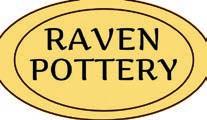
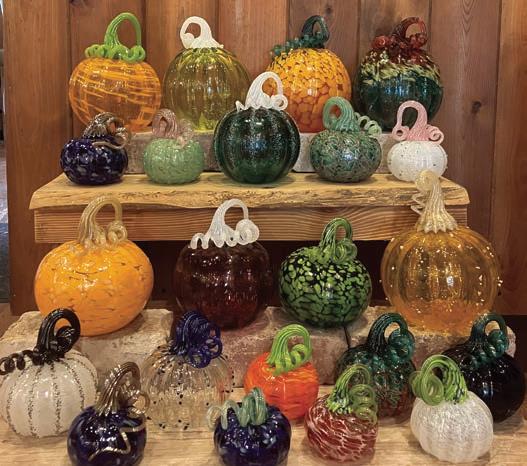






Intervention will have puppetry magic, music and fun. Lee Auditorium, 250 Voit Gilmore Lane, Southern Pines. Info: www.ticketmesandhills.com.
JAZZ SUNDAY. 2 - 4 p.m. Enjoy jazz music from the Onyx Club Boys. Tickets start at $27.50. Weymouth Center, 555 E. Connecticut Ave., Southern Pines. Info: www.weymouthcenter.org.
HISTORY PRESENTATION. 2:30 p.m. Join Carley Sutton for a presentation of A Short History of Southern Pines. Enjoy historic photos, stories and factoids. Bring your curiosity for the Q&A at the end. Southern Pines Public Library, 170 W. Connecticut Ave., Southern Pines. Info: (910) 692-8235 or www. sppl.net.
Monday, October 28
AUDITIONS. The Sunrise Theater is holding auditions for Time and a Half. There will be another round of auditions on Oct. 30. Sunrise Theater, 250 N.W. Broad St., Southern Pines. Info: (910) 692-3611 or www.sunrisetheater.com.
Tuesday, October 29
JAM SESSION. 6 - 9 p.m Bring your own instrument and beverage or just come to enjoy the music in the Weymouth Great Room. All skill levels and all instruments are welcome. Open to the public. Registration appreciated. Weymouth Center, 555 E. Connecticut Ave., Southern Pines. Info: www. weymouthcenter.org.
Thursday, October 31
WELLNESS CLASSES. 10 - 11:30 a.m. For adults 18 and older. Enjoy educational topics that provide information to improve the overall mind, body and spirit. Free of charge. Douglass Community Center, 1185 W. Pennsylvania Ave., Southern Pines. Info: (910) 692-7376.
DOUGLASS CENTER BOOK CLUB. 10:30 a.m. Multiple copies of the selected book are available for checkout at the library. The Douglass Community Center, 1185 W. Pennsylvania Ave., Southern Pines. Info: mmiller@sppl.net.
MEDICAL MINUTES. 1 - 2 p.m. Adults 55 and older are invited to learn different topics each month helpful to the senior community. Free of charge. Douglass Community Center, 1185 W. Pennsylvania Ave., Southern Pines. Info: (910) 692-7376.
Friday, November 1
TRACTOR AND TRAIN SHOW. 8 a.m. Join a fun-filled, three-day family event. There will be a tractor parade, games, antique auction, “money in the haystack” and more. The event continues through Nov. 3. Ederville, 644 Niagara-Carthage Road, Carthage. Info: www.edervillenc.com.
PAWS FOR CELEBRATION. 6 - 9 p.m. Moore Humane Society’s auction and gala features fantastic items from around the world up for grabs. There will be a virtual auction, raffle, music, and a full dinner. Tickets are $125. Fair Barn, 200 Beulah Hill Road N., Pinehurst. Info: www.moorehumane. org.
Saturday, November 2
CHORAL SHOW. 7 - 9 p.m. The Golf Capital Chorus presents its 43rd anniversary show, “Songs for All Seasons.” Proceeds benefit local charities. Lee Auditorium, Pinecrest High School, 250 Voit Gilmore Lane, Southern Pines. Tickets available online at Ticket Me Sandhills and in person at R.Riveter, Provision Ace Hardware, Heavenly Pines and Pine Scone Cafe. Info and tickets: www. ticketmesandhills.com.
Friday, November 8
DENIM AND GLITZ. 6 - 10 p.m. Put on your favorite jeans for an evening benefiting Changing Destinies Ministry, an anti-human trafficking organization. There will be music, auctions, a buffet dinner and more. Fair Barn, 200 Beulah Hill Road S., Pinehurst. Info: www.changingdestiniesministry. org.
Thursday, November 14
SYMPHONY. 7:30 - 9:15 p.m. International superstar pianist Stephen Hough brings his special brand of genius to the stage alongside the North Carolina Symphony as they perform Beethoven’s sweeping Piano Concerto No. 3, led by music director Carlos Miguel Prieto. Owens Auditorium, 3395 Airport Road, Pinehurst. Info: www.ncsymphony.org.
Mondays
WORKSPACES. 7 a.m. - 3 p.m. The Given Tufts Bookshop has a new pop-in co-workspace open on Mondays and Thursdays in the upstairs conference room. Bookshop floor and private meeting room by reservation only. Info: www.giventuftsfoundation. com.
WORKOUTS. 8:30 a.m. - 4:30 p.m. Adults 55 and older are invited to get their workout on. Open Monday through Friday. Cost for six months: $15/ resident; $30/non-resident. Douglass Community Center, 1185 W. Pennsylvania Ave., Southern Pines. Info: (910) 692-7376.
CHAIR YOGA. 9 - 10 a.m. For adults 55 and older. Help offset body aches encountered with desk work. This is an accessible yoga class for bodies not able to easily get up from and down to the floor. Do standing or sitting in a chair. Douglass Community Center, 1185 W. Pennsylvania Ave., Southern Pines. Info: (910) 692-7376.
STRENGTH AND BALANCE WORKOUT. 1111:45 a.m. Adults 55 and older are invited to enjoy a brisk workout that focuses on balance and strength. Free of charge. Douglass Community Center, 1185 W. Pennsylvania Ave., Southern Pines. Info: (910) 692-7376.
RESTORATIVE YOGA. 12 p.m. For adults 55 and older. Practice gentle movements designed to improve well-being, help alleviate pain and improve circulation. Bring your own mat. Free of charge. Douglass Community Center, 1185 W. Pennsylvania Ave., Southern Pines. Info: (910) 692-7376.
GAME ON. 1 p.m. For adults 55 and older. You and your friends are invited to play various games such as corn hole, badminton, table tennis,
shuffleboard, trivia games and more. Each week enjoy a different activity to keep you moving and thinking. Compete with friends and make new ones all for free. Douglass Community Center, 1185 W. Pennsylvania Ave., Southern Pines. Info: (910) 692-7376.
TAI CHI. 1 - 2 p.m. Adults 55 and older are invited to learn tai chi for arthritis and fall prevention. Free of charge. Classes go through Oct. 16. Douglass Community Center, 1185 W. Pennsylvania Ave., Southern Pines. Info: (910) 692-7376.
BRIDGE. 1:30 - 4:30 p.m. For adults 55 and older. Enjoy games of bridge with friends. Douglass Community Center, 1185 W. Pennsylvania Ave., Southern Pines. Info: (910) 692-7376.
Tuesdays
PLAYFUL LEARNING. 10 a.m. - 2 p.m. Come for a drop-in, open playtime for ages 0 - 3 years to interact with other children and have educational playtime. Given Memorial Library, 150 Cherokee Road, Pinehurst. Info: (910) 295-3642.
BABY RHYMES. 10:15 a.m. Baby Rhymes is specially designed for the youngest learners (birth2) and their caregivers. Repetition and comforting movements make this story time perfect for early development and brain growth. There will be a duplicate session at 10:45 a.m. An active library card is required. Dates this month are Oct. 1, 8, 15, 22 and 29. Southern Pines Public Library, 170 W. Connecticut Ave., Southern Pines. Info: (910) 6928235 or www.sppl.net.
GAME DAY. 12 p.m. Enjoy bid whist and other cool games all in the company of great friends. For adults 55 and older. Douglass Community Center, 1185 W. Pennsylvania Ave., Southern Pines. Info: (910) 692-7376.
CHESS. 1:30 - 5 p.m. Come join a chess group, whether you have been playing for a while or you have never played. This is a free program. Moore County Senior Enrichment Center, 8040 U.S. 15501, West End.
LINE DANCE. 4:45 p.m. Put on your dancing shoes and line dance. This is for beginners and is a free program. Moore County Senior Enrichment Center, 8040 U.S. 15-501, West End.
CHAIR YOGA. 10 - 11 a.m. For adults 55 and older. Help offset body aches encountered with desk work. This is an accessible yoga class for bodies not able to easily get up from and down to the floor. Do standing or sitting in a chair. Douglass Community Center, 1185 W. Pennsylvania Ave., Southern Pines. Info: (910) 692-7376.
BRAIN BOOST. 10 - 11 a.m. Test your memory while creating new brain connections. This is a free program. Moore County Senior Enrichment Center, 8040 U.S. 15-501, West End.
KNITTING. 10 - 11 a.m. Learn how to knit or just come enjoy knitting with other people. This is a free program. Moore County Senior Enrichment Center, 8040 U.S. 15-501, West End.
BABY STORYTIME. 10 - 11 a.m. Have fun developing the foundation for your baby’s later reading







with stories, songs, and play. Open to parents and caregivers of infants from newborn to 24 months. Moore County Library, 101 W. Saunders St., Carthage. Info: (910) 947-5335.
LEARN AND PLAY. 10 a.m. - 12 p.m. Come to an open play date with your toddler or preschooler where there will be developmental toys and puzzles as well as early literacy tips on display for parents and caregivers to incorporate in their daily activities. Dates this month are Oct. 2, 9, 16, 23 and 30. Southern Pines Public Library, 170 W. Connecticut Ave., Southern Pines. Info: (910) 692-8235 or www. sppl.net.
JEWELRY MAKING. 10:30 - 11:30 a.m. Adults 55 and older are invited to come with friends and create fun designs and memories. Supplies are provided. Douglass Community Center, 1185 W. Pennsylvania Ave., Southern Pines. Info: (910) 692-7376.
IMPROV ACTING CLASS. 11 a.m. - 12 p.m. For adults 55 and older. Are you ready to laugh and have fun? Sign up for an improvisational acting class. Free of charge. Douglass Community Center, 1185 W. Pennsylvania Ave., Southern Pines. Info: (910) 692-7376.
PIANO. 11 a.m. - 12 p.m. Join Flint Long to either play piano or just listen. This is a free program. Moore County Senior Enrichment Center, 8040 U.S. 15-501, West End.

LINE DANCING. 12 - 1 p.m. Looking for new ways to get your daily exercise in and care for yourself? Try line dancing. For adults 55 and older. Douglass Community Center, 1185 W. Pennsylvania Ave., Southern Pines. Info: (910) 692-7376.
CHAIR VOLLEYBALL. 1 - 2 p.m. For adults 55 and older. Get fit while having fun. Free to participate. Douglass Community Center, 1185 W. Pennsylvania Ave., Southern Pines. Info: (910) 692-7376.
BRIDGE. 1:30 - 4:30 p.m. For adults 55 and older. Enjoy games of bridge with friends. All materials included. Douglass Community Center, 1185 W. Pennsylvania Ave., Southern Pines. Info: (910) 692-7376.
DANCE. 2 - 2:30 p.m. For adults 55 and older. Instructor Maria Amaya will teach dance fitness in a class designed for anyone who wants to gently and gradually increase cardio function, mobility and balance, and have fun at the same time. Free of charge. Douglass Community Center, 1185 W. Pennsylvania Ave., Southern Pines. Info: (910) 692-7376.
LINE DANCING. 2 p.m. The town of Vass hosts line dancing for seniors every other Wednesday. Cost is $5 per session. Vass Town Hall, 140 S. Alma St., Vass. Info: www.townofvassnc.gov.
TAI CHI. 2 - 3 p.m. Adults 55 and older are invited to learn tai chi for arthritis and fall prevention. Free
of charge. Classes go through Oct. 16. Douglass Community Center, 1185 W. Pennsylvania Ave., Southern Pines. Info: (910) 692-7376.
IMPROVISATIONAL ACTING. 3 - 4 p.m. For adults 55 and older. Unleash creativity, embrace the unexpected, and share some laughter together in a dynamic and engaging art form. Free of charge. Douglass Community Center, 1185 W. Pennsylvania Ave., Southern Pines. Info: (910) 692-7376.
SANDHILLS FARMERS MARKET. 3 - 6 p.m.
The Sandhills Farmers Market features some of the many wonderful farms, nurseries, bakeries, meat and egg providers, cheesemakers and specialty food producers our area has to offer. You will find this incredible mix of vendors twice a week at Tufts Memorial Park through Oct. 5. Tufts Memorial Park, 1 Village Green Road W., Pinehurst. Info: www.vopnc.org.
LIBRARY PROGRAM. 3:30 p.m. At The Library After School (ATLAS) is an after-school program for K - 2nd graders who enjoy activities, crafts, stories and meeting new friends. Dates this month are Oct. 2, 9, 16, 23 and 30. Southern Pines Public Library, 170 W. Connecticut Ave., Southern Pines. Info: (910) 692-8235 or www.sppl.net.
TAI CHI. 6:30 p.m. Learn tai chi. There is no age limit and the classes are open to the public. Cost is $10 per class. Seven Lakes West Community Center, 556 Longleaf Drive, Seven Lakes. Info: (910) 400-5646.











Thursdays
WORKSPACES. 7 a.m. - 3p.m. The Given Tufts Bookshop has a new pop-in co-workspace open on Mondays and Thursdays in the upstairs conference room. Bookshop floor and private meeting room by reservation only. Info: www.giventuftsfoundation. com.
MOORE COUNTY FARMERS MARKET. 9 a.m. - 1 p.m. The year-round market features “producer only” vendors within a 50-mile radius providing fresh, local and seasonal produce, fruits, pasture meats, eggs, potting plants, cut flowers and local honey. Crafts, baked goods, jams and jellies are also available. Market is located at the Armory Sports Complex, 604 W. Morganton Road, Southern Pines.
GIVEN STORY TIME. 10 a.m. Bring your preschooler to enjoy stories, songs and activities. Given Memorial Library, 150 Cherokee Road, Pinehurst. Info: (910) 295-3642.
BALANCE AND FLEXIBILITY. 10 - 11 a.m.
Adults 55 and older are invited to enjoy a class that can reduce the risk of taking a tumble and increase the ability to recover if you do. Free of charge. Douglass Community Center, 1185 W. Pennsylvania Ave., Southern Pines. Info: (910) 692-7376.
MUSIC AND MOTION. 10:15 and 10:45 a.m. Does your toddler like to move and groove? Join
Music and Motion to get those wiggles out and work on gross and fine motor skills. For ages 2 - 5. An active library card is required. Dates this month are Oct. 3, 10, 17 and 24. Southern Pines Public Library, 170 W. Connecticut Ave., Southern Pines. Info: (910) 692-8235 or www.sppl.net.
CROCHET CLUB. 11 a.m. - 12 p.m. Adults 55 and older are invited to come with friends to create fun designs and memories. Supplies are on site. Free of charge. Douglass Community Center, 1185 W. Pennsylvania Ave., Southern Pines. Info: (910) 692-7376.
STRETCH, STRENGTH, BALANCE. 11 a.m.12 p.m. Adults 55 and older can enjoy exercises to improve overall quality of life. Exercises can be performed standing or seated. Free of charge. Douglass Community Center, 1185 W. Pennsylvania Ave., Southern Pines. Info: (910) 692-7376.
ADAPTIVE YOGA. 12 - 1 p.m. Adults 55 and older can enjoy yoga that meets them where they are, creating a sense of balance and ease by slowly increasing range of motion and mobility while maintaining natural abilities. Free of charge. Douglass Community Center, 1185 W. Pennsylvania Ave., Southern Pines. Info: (910) 692-7376.
CHESS AND MAHJONG. 1 p.m. For adults 55 and older. Bring a board and your friend. Douglass Community Center, 1185 W. Pennsylvania Ave., Southern Pines. Info: (910) 692-7376.
CABIN TOURS. 1 - 4 p.m. The Moore County Historical Association’s Shaw House grounds, cabins and gift shop are open for tours and visits. The restored tobacco barn features the history of children’s roles in the industry. Docents are ready to host you and the cabins are open Thursdays, Fridays and Saturdays. Shaw House, 110 W. Morganton Road, Southern Pines. Info: (910) 6922051 or www.moorehistory.com.
IMPROVERS LINE DANCE. 3 - 5:30 p.m. Put on your dancing shoes and line dance. This is a free program. Moore County Senior Enrichment Center, 8040 U.S. 15-501, West End.
LITTLE U. 3:30 p.m. Introducing Little U, Southern Pines Public Library’s new preschool program for children ages 3 1/2 – 5, featuring stories, songs, rhymes, and activities that explore the world of books, language and literacy. Little U is a fun and interactive program designed to help preschoolers develop early literacy skills in preparation for kindergarten and beyond. Dates this month are Oct. 3, 10, 17 and 24. Southern Pines Public Library, 170 W. Connecticut Ave., Southern Pines. Info: (910) 692-8235 or www.sppl.net.
TRIVIA NIGHT. 7 - 9 p.m. Enjoy a beer and some trivia. Hatchet Brewing Company, 490 S.W. Broad St., Southern Pines. Info: www.hatchetbrewing. com.














Fridays
AEROBIC DANCE. 9 - 10 a.m. For adults 55 and older. Enjoy this low-to-moderate impact class with energizing music for an overall cardio and strength workout. Free of charge. Douglass Community Center, 1185 W. Pennsylvania Ave., Southern Pines. Info: (910) 692-7376.
JAM SESSION. 9:30 - 11:30 a.m. Do you like to play an instrument, sing or just listen to music? Come join a music jam session. This is a free program. Moore County Senior Enrichment Center, 8040 U.S. 15-501, West End.
TAP CLASS. 10 - 11:30 a.m. For adults 55 and older. All levels welcome. Cost per class: $15/resident; $30/non-resident. Douglass Community Center, 1185 W. Pennsylvania Ave., Southern Pines. Info: (910) 692-7376.
QIGONG. 1 p.m. For adults 55 and older. Classes will consist of chair and standing movements that can help soothe achy feet, tight hips, and lower back pain while easing restrictions in mobility. Free of charge. Douglass Community Center, 1185 W. Pennsylvania Ave., Southern Pines. Info: (910) 692-7376.
BRIDGE. 1:30 - 4:30 p.m. For adults 55 and older. Enjoy games of bridge with friends. All materials included. Douglass Community Center, 1185 W. Pennsylvania Ave., Southern Pines. Info: (910) 692-7376.
LINE DANCING. 3 - 4 p.m. For adults 55 and older. If you’re interested in learning dance moves and building confidence on the dance floor, this class is for you. Leave your inhibitions at the door and join in. Cost is: $36 for residents and $52 for non-residents per month. Cost is for a monthly membership. Douglass Community Center, 1185 W. Pennsylvania Ave., Southern Pines. Info: (910) 692-7376.
MOORE COUNTY FARMERS MARKET. 8 a.m. - 12 p.m. The market features “producer only” vendors within a 50-mile radius providing fresh, local and seasonal produce, fruits, pasture meats, eggs, potting plants, cut flowers and local honey. Crafts, baked goods, jams and jellies are also available. The market runs through November excluding Autumnfest on Saturday, Oct. 5. Downtown Southern Pines, 156 S.E. Broad St., Southern Pines.
SANDHILLS FARMERS MARKET. 10 a.m. - 1 p.m. The Sandhills Farmers Market features some of the many wonderful farms, nurseries, bakeries, meat and egg providers, cheesemakers and specialty food producers our area has to offer. You will find this incredible mix of vendors twice a week at Tufts Memorial Park through October 5. Tufts Memorial Park, 1 Village Green Road W., Pinehurst. Info: www.vopnc.org.




We are excited to welcome back Paperhand Puppet Intervention! This puppet (think Lion King puppets) troupe has been performing for over 23 years. So, for all you kids and kids at heart - get your tickets today for an afternoon full of puppetry magic, music and fun!
Benefitting Sandhills Coaltion for Human Care
$20 (plus tax) in Advance • $27 (plus tax) at the Door $12 Children (4-14) • 3 & under FREE







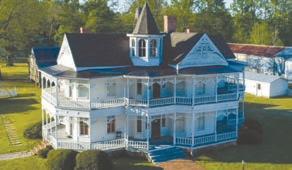



Tractor Games

Dr. Tim Altman (trumpet) and Dr. Mark Tollefsen (piano) will present a program of trumpet and piano works including Baroque trumpet by Handel (Suite, 1733), Haydn’s Concerto in E-flat Major for trumpet and piano, Herbert L. Clarke’s cornet solo (1912), and a movement from Eric Ewazen’s Sonata for Trumpet and Piano (1995).



Opening Reception
Friday, October 4 5:00-7:00
Celebrating the human form, our October exhibit will showcase portraits and figures by members of the Artists League and will feature a variety of styles and mediums. Please join us for the opening reception or stop in during the month. The exhibit will be on display through Friday, October 25.
Thursday, November 7 • 5:00-7:30

Our annual private opening reception is by invitation only and is our most spectacular event of the year. This is a lovely reception held prior to the public opening of the exhibit. Exquisite food and a special cocktail based on our theme are served to our guests. Admission is $125 per couple and $100 may be applied to the price of any painting (or can be counted as a donation if you don’t make a purchase).
Please plan to join us that evening and have first choice to purchase a truly unique piece of art and help support the Artists League. Call for an invitation to our “Fiesta” celebrating the spectacular private opening reception of our fall exhibit.
Opening Reception and Weekend:
Friday, November 8 5:00-7:00
Please join us for the public opening reception of the Artists League’s 30th Annual Art Exhibit and Sale. The opening weekend continues on Saturday, November 9, from 11:00 to 3:00 p.m. The exhibit and sale will remain open through Friday, December 20th.



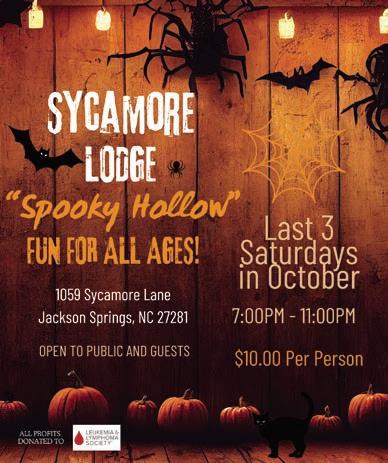
Carlos Miguel Prieto, conductor
Stephen Hough, piano
Gibson: warp & weft
Beethoven: Piano Concerto No. 3
Brahms: Symphony No.1














































Weymouth Peach Grass Festival
July 27, 2024
Photographs by Diane McKay
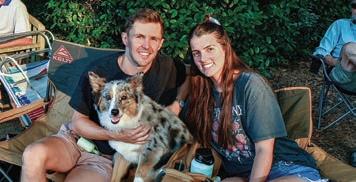








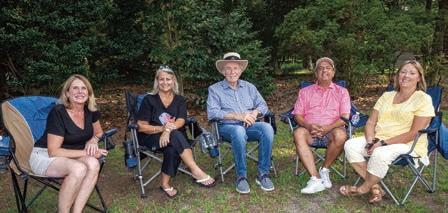


Moore County Arts Council
Fine Arts Festival Reception
August 2, 2024
Photographs by Diane McKay






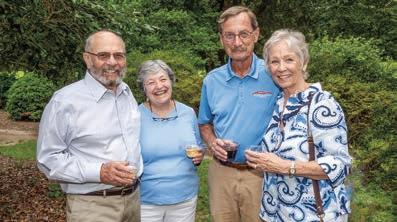



www.warpathmilitaria.com
























Across
1. Greek alphabet's seventh letter
1. Greek alphabet’s seventh letter
5. Exclamation acknowledging a mistake
9. Response request on invitations
13. Extreme pain or distress
56. Hard, glossy coating
5. Exclamation acknowledging a mistake
60. Measure of surface extent
61. Agreeable attitude (2 wds)
9. Response request on invitations
13. Extreme pain or distress
63. Microscope’s magnifying component
14. Ancient Roman numeral for eight
14. Ancient Roman numeral for eight
15. Brazilian berry touted as superfood
16. Fall decor
18. Precipitation from clouds
64. Place of residence
65. Mythical creature, halfwoman and half-serpent
15. Brazilian berry touted as superfood
16. Fall Decor
66. Actor McConaughey, for short
18. Precipitation from clouds
67. Twist or turn to one side
19. Large property or land holding
68. “What ____is new?”
20. Cowboy movie genre
19. Large property or land holding
20. Cowboy movie genre
22. Narrow horizontal surface projecting from a wall
22. Narrow horizontal surface projecting from a wall
24. Christmas ____ Log
1. These might get bruised in an argument
24. Christmas ____Log
2. Civil wrong in law
25. Translucent fabric used for theater curtains
25. Translucent fabric used for theater curtains
28. Not young or new
30. Stretchy synthetic fabric
33. Mineral-bearing rocks
34. Spring-blooming flowers
36. Curved bone in the chest
3. Recorder of historical events
28. Not young or new
30. Stretchy synthetic fabric
33. Mineral-bearing rocks
4. Organized set of interconnected parts
34. Spring-blooming flowers
5. Female reproductive cells
36. Curved bone in the chest
37. Period following a conflict
6. Drilling site for petroleum extraction (2 wds)
7. Long-bodied freshwater fish
39. Crunchy breakfast cereal
41. Expression of confusion
37. Period following a conflict
39. Crunchy breakfast cereal
41. Expression of confusion
8. Derogatory term for an effeminate male
42. English director Scott (Alien, Thelma and Louise)
27. Act of sending goods again
65. Mythical creature, halfwoman and half-serpent
9. Not often or frequently
44. Female sheep
42. English director Scott (Alien, Thelma and Louise)
44. Female sheep
10. Fall decor
45. Tall, tapering structure on a building
50. Audible exhalations of breath
52. Poetic contraction of “even”
10. Fall Decor
29. Process food in the belly
31. Irritates or annoys
66. Actor McConaughey, for short
32. Humiliate or degrade
11. Excessively proud of one's appearance
34. Chinese ethnic group
67. Twist or turn to one side
11. Excessively proud of one’s appearance
47. Informal term for a sibling
45. Tall, tapering structure on a building
68. "What ____is new?"
Down
12. Small, pointed sewing fasteners
48. Broadway choreographer for Cabaret
47. Informal term for a sibling
48. Broadway choreographer for Cabaret
13. Expert or top performer
35. Be nosy
12. Small, pointed sewing fasteners
38. ____havoc
1. These might get bruised in an argument
17. Cheers actor Danson
49. Small, round green legumes
21. Oklahoma’s second-largest city
23. Fall decor
51. Large beer mug
53. Fall Decor
49. Small, round green legumes
51. Large beer mug
53. Fall decor
56. Hard, glossy coating
60. Measure of surface extent
53. Tropical tree with large leaves
40. Relating to newborn infants
54. Nitrogen-containing compound in urine
43. Gracefully slender and flexible
46. Meal or feast
55. Small, secluded corner
13. Expert or top performer
17. "Cheers" actor Danson
40. Relating to newborn infants
43. Gracefully slender and flexible
2. Civil wrong in law
21. Oklahoma's secondlargest city
23. Fall Decor
46. Meal or feast
3. Recorder of historical events
48. Concluding part
4. Organized set of interconnected parts
25. Students after freshmen, for short
5. Female reproductive cells
26. Respiratory condition with a barking cough
61. Agreeable attitude (2 wds)
63. Microscope's magnifying component
64. Place of residence

6. Drilling site for petroleum extraction (2 wds)
7. Long-bodied freshwater fish
Fill in the grid so every row, every column and every 3x3 box contain the numbers 1-9.
8. Derogatory term for an effeminate male
9. Not often or frequently
Puzzle answers on page 117
Mart Dickerson lives in Southern Pines and welcomes suggestions from her fellow puzzle masters. She can be reached at martaroonie@gmail.com.
48. Concluding part
57. Fall decor, for short
58. One of the Great Lakes
50. Audible exhalations of breath
59. Meadow or grassland
52. Poetic contraction of "even"
62. Morning condensation
25. Students after freshmen ,for short
26. Respiratory condition with a barking cough
27. Act of sending goods again
29. Process food in the belly
31. Irritates or annoys
32. Humiliate or degrade
34. Chinese ethnic group
35. Be nosy
38. ____havoc
53. Tropical tree with large leaves
54. Nitrogen-containing compound in urine
55. Small, secluded corner
57. Fall Decor, for short
58. One of the Great Lakes
59. Meadow or grassland
62. Morning condensation
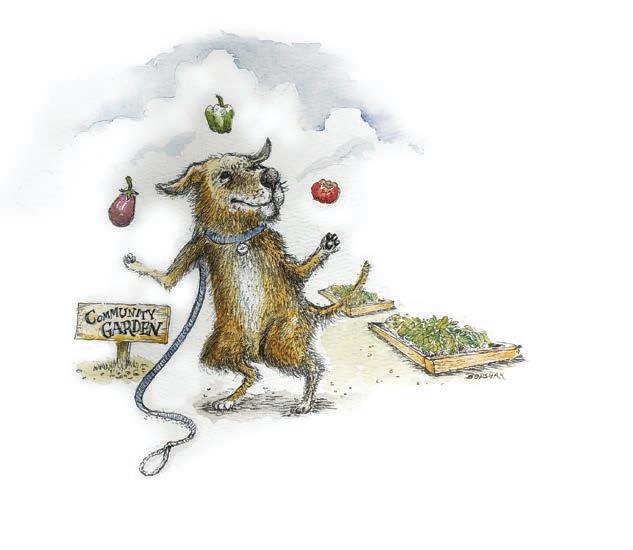
By Beth M acDonalD
I’musually the person others make an example of. So when I nervously moved to a very public apartment building in bucolic Pinehurst, I was anxious about all the rules I would accidentally break. If the complex had a yearbook, I’d surely be voted most likely to get fined.
Someone once told me to be less obvious about being awkward. “Don’t just throw it out there. Be more subtle,” they cautioned, as if opening my mouth didn’t give me away. I trip while standing still. I own being weird. I have tea towels that say “Don’t Trust Anyone Who Can Spell Gonorrhea On The First Try.” That’s gotta be a fine.
I adopted a sweet dog who is as clumsy as I am. It has already tried to clothesline me with the leash at least 6,475 times and pooped on the sidewalk. I wasn’t about to get fined for that so I found a new talent in scrubbing concrete.
I learned that my precious large dog is afraid of tiny dogs. Very afraid. One evening a very small dog activated my dog’s Power Ranger mode. He took off, knocked me down, dragged me a few feet at the end of the leash (I mean, who’s leashed to who here?), and then disappeared. I got to my feet and proceeded to canvas the 745 witnesses. Which way did he go? Everyone pointed in a different direction. He had run straight home, jumped the patio fence, and was tapping his paw and wagging his tail impatiently waiting for me after my 30-minute search.
My lovely new complex (living, not psychological) has a putting green, dog park, pool, playground and courtyard. It also has a gardening spot. I didn’t know if it was a community gardening spot open to all or if it was
There’s a fine for that
specific to one or two tenants. I just knew that I passed it on my way to my concrete scrubbing job.
I do know I didn’t plant anything there. Much like a cornfield or cotton field one sees on a country road, I didn’t plant it, so I don’t pick it. I do have a few herbs on my patio. Legal herbs. I carefully planted them in little pots that say “Plant Coffin” and “Pray for Me.” Some people have a green thumb, I have the kiss of death. Often, it’s a quick end. Sometimes they linger, suffering a slow and painful demise after an overwatering torture ritual.
Today I passed the garden and there was a giant sign posted that said, “Food is not free, farmers tend to these gardens.” Apparently I am no longer the frontrunner in the neighborhood crime wave. Someone is going to pay a hefty fine for this, and it won’t be me. Yes! I decided to investigate, CSI Apartment-style.
By the looks of the hastily scrawled writing on the sign, the victim is very angry. Perhaps someone had absconded with a prize tomato destined for a promising caprese. You don’t just let something like that go. I even began to worry about the exposed basil on my patio. Was that in danger too? The sign is by the sidewalk. Was it a drive-by? A random act? I don’t think so. I think it was deliberate. I think it was an insidethe-courtyard job; this didn’t come from beyond the sidewalk. The perp knows what they’re doing. Have they been driven underground, maybe started smuggling their veggies out of Harris Teeter? Was this a hate crime? No. There aren’t any smashed tomatoes.
I know one thing: I need to find a hobby. I thought about writing something on the bottom of the sign:
Dog Walker Seeks Hobby
(Vegetable perp interested in socially constructive activities should contact woman conducting garden investigation for more details.)
Is that too obvious a trap?
I met the gardener in the natural course of my investigation. He is such a kind man! He didn’t deserve this. I also found out it was a pepper. He didn’t have a recent photo. The description was “green and shiny.” My basil might be safe.
It turns out this vegetable thievery is a recurring problem. Hooligans live among us. I have since started my own Neighborhood Garden Watch Program from my patio. I bought a pair of binoculars and some night vision goggles.
Between my dog fines and the CSI Garden crimes, I have gotten to know several neighbors. All of them are so kind. They have even forgiven me my tea towels. PS
Beth MacDonald is a suburban misadventurer, author and essayist who often tries to get out of her car without unfastening her seat belt.












